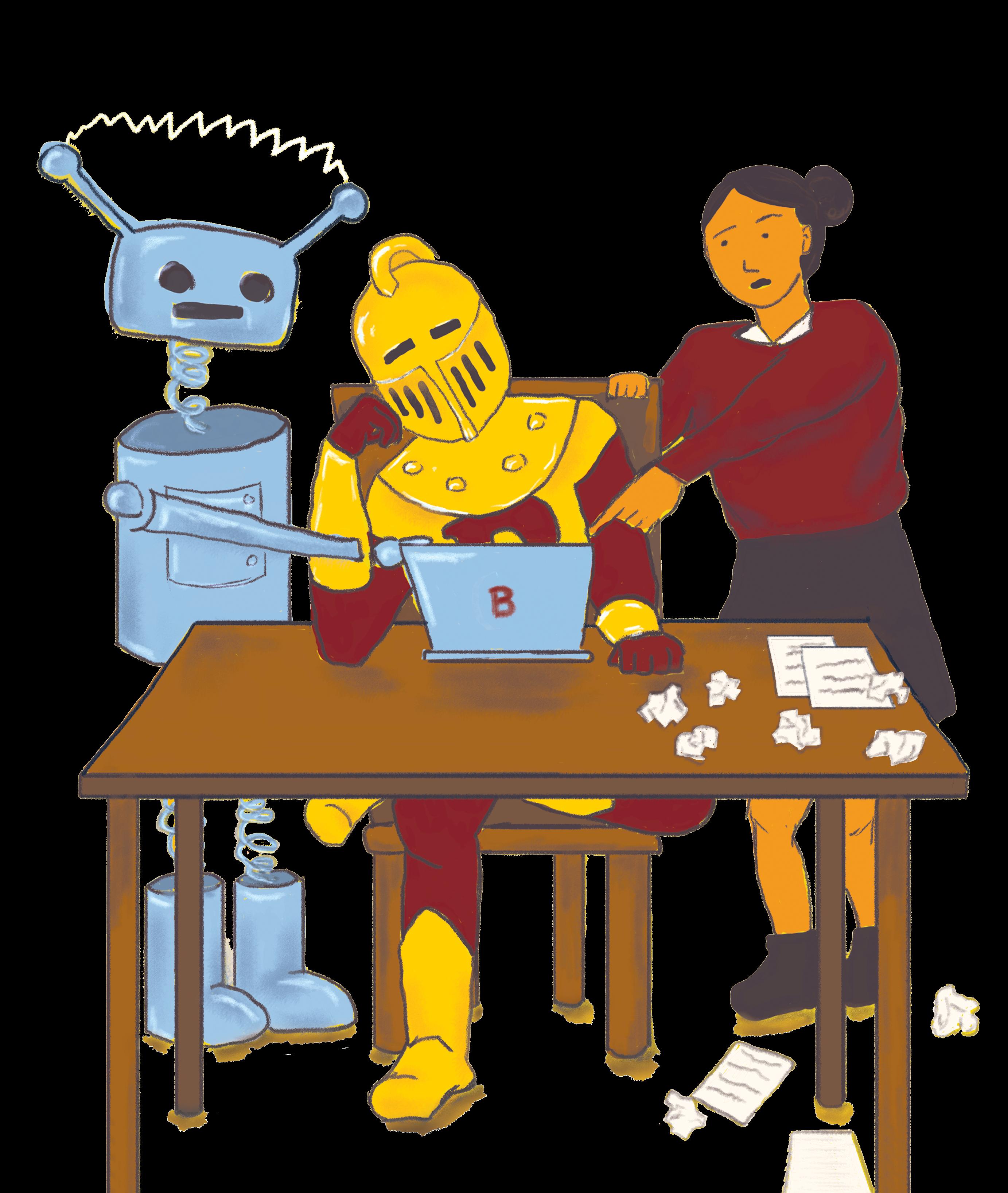
Understanding AI’s Potential at Bishop’s Bishop’s Robotics in the Real World
2
4
6
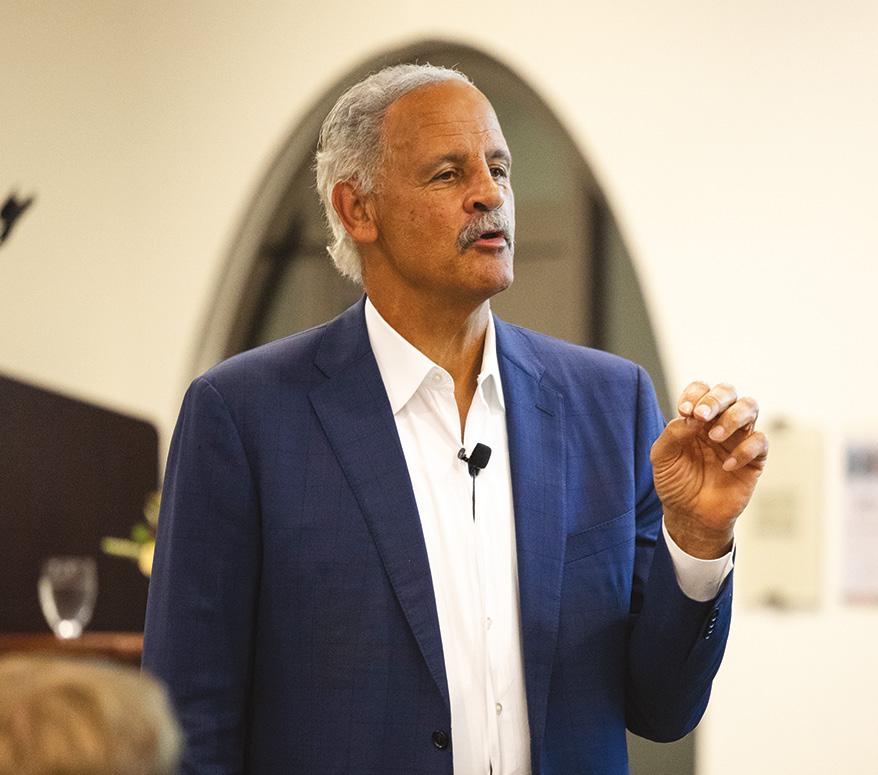


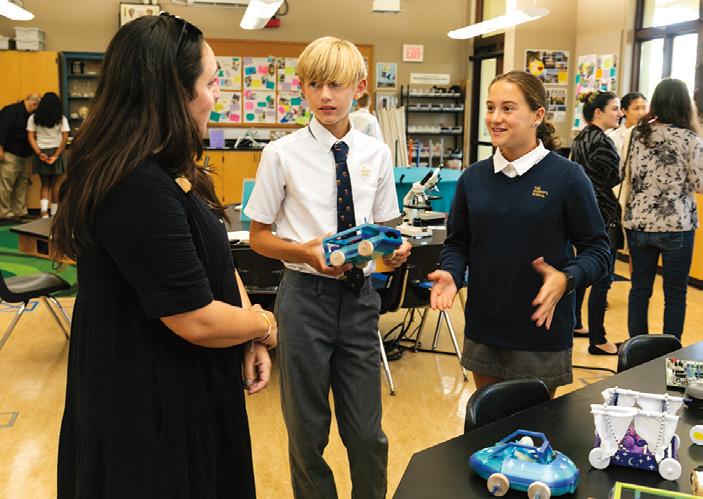
A magazine for The Bishop’s School community
Winter 2024 • Vol. 21 No. 1
Credits
Editor
Cathy Morrison
Assistant Editor
Jen Jordan
Contributing Writers
Mac Armstrong ’93
Ana Graczyk
Zach Harris
Emily Hassig
Zach Jones ’01
Jen Jordan
Maya Kim
Ron Kim
Ashley Mackin-Solomon
Cathy Morrison
Jared Scott Tesler
Graphic Design Design Perspective, Inc.
Printer
Neyenesch Printers, Inc.
Contributing Illustrator
Maya Kim
Contributing Photographers
Annie Denten, Studio M Photography
iStock Photo
Jen Jordan
Lani Keller
Michael Meek ’05
Cathy Morrison
Dave Siccardi
Sarah Lina Sparks
Michael Spengler, Studio M Photography
Valissa Thomas
Matthew Valji
The Bishop’s School
Head of School
Ron Kim
Chief Advancement Officer
Emily Hassig
Senior Director of Alumni Engagement and Annual Giving
Lori Boyle
Bishop’s is published twice a year by The Bishop’s School.
We welcome your feedback. Please send story ideas to news@bishops.com or contact us at (858) 875-0710.
The Bishop’s School 7607 La Jolla Boulevard La Jolla, CA 92037-4799
Phone: (858) 459-4021
www.bishops.com
Mission Statement
Bishop’s is an Episcopal school that nurtures students of intellect and character to think independently, learn collaboratively, grow their sense of self and act with greater purpose.
Back Cover:
Defining “purpose” at Bishop’s
Front Cover: Considering the role of AI illustration by Maya Kim
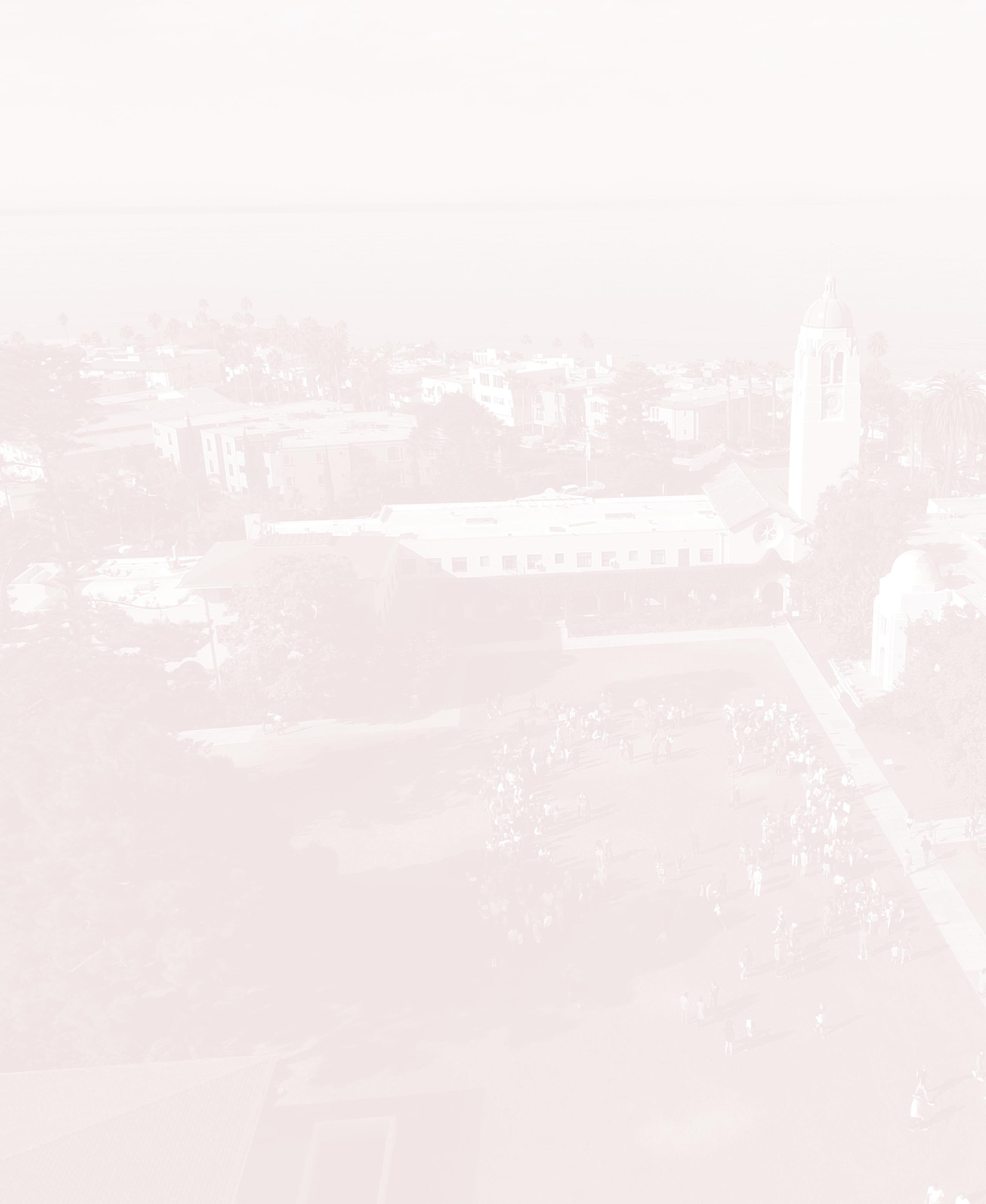
table
4
of contents BISHOP’S
10 FEATURES
AI in Education What uses get the green light at Bishop’s?
Do You Know WHO You Are? Stedman Graham on Identity Leadership
Poet Paisley Rekdal Mulgrew Series November guest
5
A History Lover’s Dream Ron Kim aboard the USS Carl Vinson
Bishop’s Robotics in the Real World Team competes in Bordeaux, France 10 Modeling Diplomacy KnightsMUN December conference 12 Alumni Careers in Athletics A roundtable conversation 15 Fall Athletics Update Knights add league titles 16 Bish Bowl & Reunion 2023 A spirited weekend for all 18 Bishop’s Past, Present & Future Michael Teitelman and Ron Kim 19 Teitelman Science Center Celebration 15-year anniversary of dedication 20 A New Voice for DEIJ Welcome Valissa Thomas 21 PoCC/ SDLC Inspiring conferences 22 Well-Deserved National Recognition Vivien Valenzuela Mallick honored 23 Family Matters Class notes, alumni stories and transitions 41 IMPACT REPORT 2023 Thank you for supporting Bishop’s! 16 19
8
on the quad with RK
If you are like me, a year ago you were not thinking much about artificial intelligence. The term generative AI was unfamiliar. Almost certainly you had not heard of ChatGPT. Now, a year later, AI seems to be everywhere. Internet searches about AI have risen fivefold over this past year. AI’s ability to complete school assignments aroused immediate concern in educational circles. You may wonder what this all means for Bishop’s.
I welcome you to read the feature article that reflects the nuanced and evolving ways in which we are thinking about AI as a new and powerful tool. A colleague of mine once noted that technology is not polite. It does not ask if it’s okay to enter. It intrudes. For us, as educators, it requires understanding and adaptation. It is a challenging but also familiar process, and each time this happens we find ourselves returning to fundamental values.
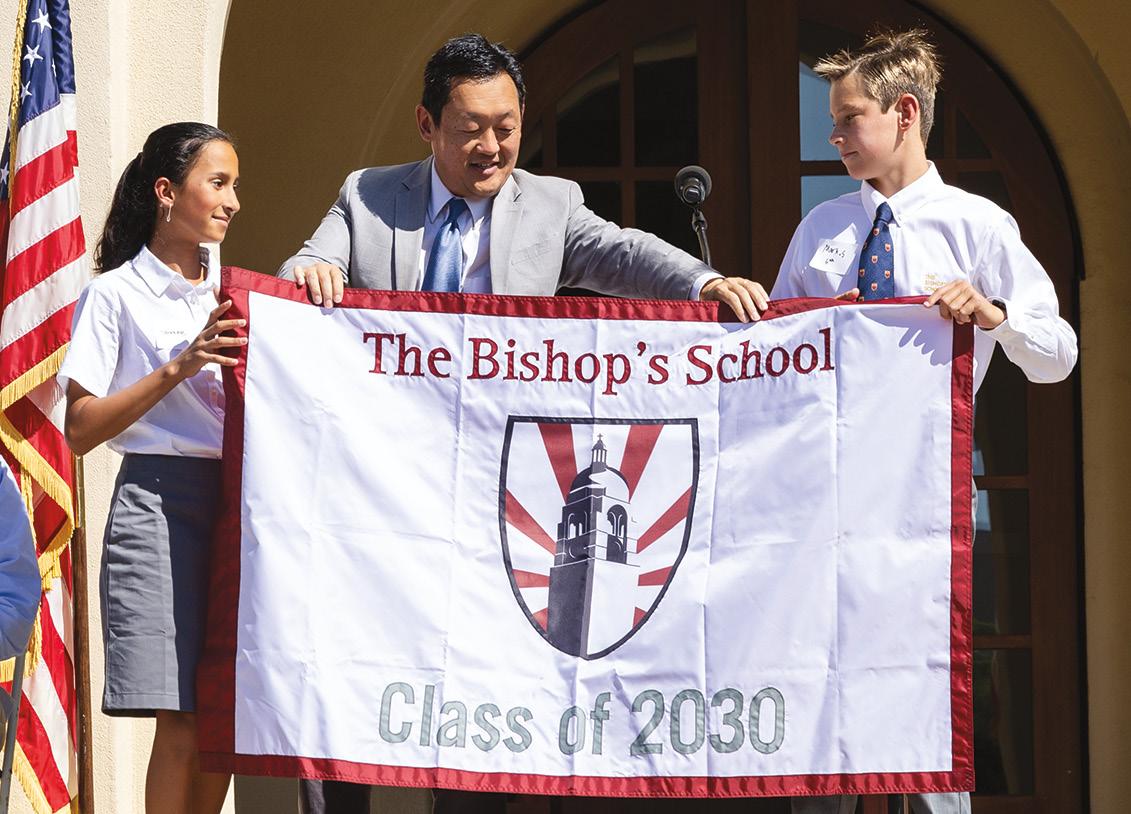
The vision for Bishop’s asks a question: How do our students learn and grow best? We know that no matter what kind of technology intrudes, students learn best from teachers who know them and care about them. Optimal learning is always and ultimately inspired by great relationships between teachers and students. To paraphrase the legendary basketball coach Tara VanDerveer, our role in schools is to help students go where they could not go by themselves. AI has actually reminded us of the enduring value of the Bishop’s experience. We are blessed to have a community where teachers and students know each other in ways that technology never can, and we can challenge and support each other in ways that help us reach our full potential.
No doubt technology will continue to present challenges (and opportunities), but you will find throughout the magazine evidence of what makes Bishop’s so special—teachers, students and alumni with shared values, acting with greater purpose.
Ron Kim Head of School
1 on the quad with RK
in Education
The conversation on generative artificial intelligence (AI) in education was prompted by the release of ChatGPT by OpenAI in November 2022. ChatGPT is trained using the vast collections of text data available online to generate responses to user prompts and questions. AI can do anything from holding a casual conversation to generating entire essays based on the user’s prompt. The introduction of AI triggers many different reactions among educators from fear to excitement, with the understanding that this technology will change education forever. What is the way forward for educators?
By Maya Kim
Bishop’s faculty have had multiple meetings on the topic
At the start of the school year, Assistant Head of School Brian Ogden and history teacher Matthew Valji presented to both faculty and board members on the emergence of AI and offered guidelines for what AI could mean for Bishop’s students.
Their emphasis is on how teachers can adapt to AI by better understanding its uses as well as recognizing when it is being used. Valji came up with an analogy of a traffic light to help the community visualize incorporating AI in an approachable way. He says, “I considered that there were some case uses that seem reasonable and some that seem manifestly unreasonable, but there are a lot that are sort of in the middle, where I was unclear how I felt. And it was definitely going to be unclear what policies teachers would agree on.”

As artificial intelligence continues to improve, it becomes more difficult to tell if a student used ChatGPT. In fact, even AI detection tools are often unreliable in detecting whether work is AI produced. Torres-Worstell expresses frustration over the current state of AI.
“Hopefully, those kids who are serious about learning the language will roll up their sleeves and actually do the work, but I think it’s unfortunately inevitable to control what they produce unless you do it in the classroom.” The hope is that students will want to learn, but with technology so accessible, it brings concern that it is simply too easy to bypass the work.
A green light, or a reasonable case in terms of artificial intelligence, could entail a service like spellcheck, which doesn’t require students to get permission to use; a red light, or unreasonable case, could entail ChatGPT writing one’s essay for them.
The yellow light, or middle ground, is where the guidelines become murky. Valji explains this area in terms of what the students are meant to learn at different points in their education. He shares, “It depends on the skills you are trying to build for students. So, elementary school students, you’re not going to give them a calculator when you are teaching addition, subtraction, multiplication, etc. But for high schoolers, they often have an opportunity to use a calculator because their job is not to build the fundamentals, which they’ve already mastered. Their job is to use the calculator to move on to more advanced material and to build different skills.”
Instead of AI posing a threat to education, it poses an opportunity as a tool when applied in the right circumstances. Valji uses the example of employing ChatGPT as a brainstorming tool. He prompted the Speech and Debate team to use ChatGPT as a sort of assistant so they could train on other debate skills such as research and argument crafting. This particular use is not appropriate if brainstorming is an integral part of the assignment, but can open up opportunities for honing different skills.
Artificial intelligence has not been received the same way by every department. In fact, Valji says that his colleagues in the world languages department have been experiencing this for years with the improvements of Google Translate. Julieta Torres-Worstell, Spanish teacher and former chair of the department, describes her experience. Beginning with Google Translate and now with ChatGPT, Torres-Worstell is concerned about the influence of technology on language learning. “They are not struggling with the language, which is how you learn it,” she shares. In order to assess language ability, Torres-Worstell explains that students have had to go back to doing in-class writing assignments. “I have a box for their phones and they leave their backpacks outside in the hallway to avoid any technology support that they might get where the result is not really what they can produce.”
The consequences of AI use generate questions of how teaching methods will need to change. Head of School Ron Kim shares that the topic has also been broached among school leaders. At the 2023 California Association of Independent Schools (CAIS) Heads and Trustees Annual Conference, artificial intelligence expert Dr. Vivienne Ming spoke on this new technology. Afterward, Dr. Ming was invited by Bishop’s parent and trustee Dr. Cheryl Anderson to speak to the faculty to share her insight. Kim reflects, “What Dr. Ming emphasized to us as an audience of people leading schools is that artificial intelligence is already excellent in solving well-posed problems—the kind of problems that teachers in schools have spent many years teaching students how to solve. And the question she asked us is, ‘What is the benefit of spending a lot of time teaching students how to solve well-posed problems and how relevant are students going to be if that is what they know?’” Examples of well-posed problems include book reports, summaries or essays retelling historical events. These sorts of questions can be plugged into ChatGPT and immediately answered.
Kim adds that the reaction that Bishop’s faculty had was different than other schools. “The initial reaction to artificial intelligence in schools I think was a lot of fear and for some a reflexive prohibition that if you use it you will be punished or you must not use it,” he says. He is confident that Bishop’s is in a good place to respond to these changes “because of the benefits that we have. Our teachers know our students really well. They know how they write. They know how students create ideas.” He looks toward the computer science faculty who are not alarmed by ChatGPT and intend to find ways to implement it, as well as other ways in which technology has been included in the classroom previously. ChatGPT for him does not prompt fear, but instead “arouses a lot of curiosity and impresses us as something we need to take seriously.”
Kim refers to the School’s vision statement crafted three years ago that focuses on the question, “How do students learn and grow best?” He explains this is intentionally phrased as a question with the understanding that as the world changes in unpredictable and unprecedented ways, best practices in education must adapt accordingly. The evolution of AI is one example. Bishop’s integration of this technology provides a huge challenge and opportunity for the present-day classroom.

3 AI in Education
Do You Know WHO You Are?
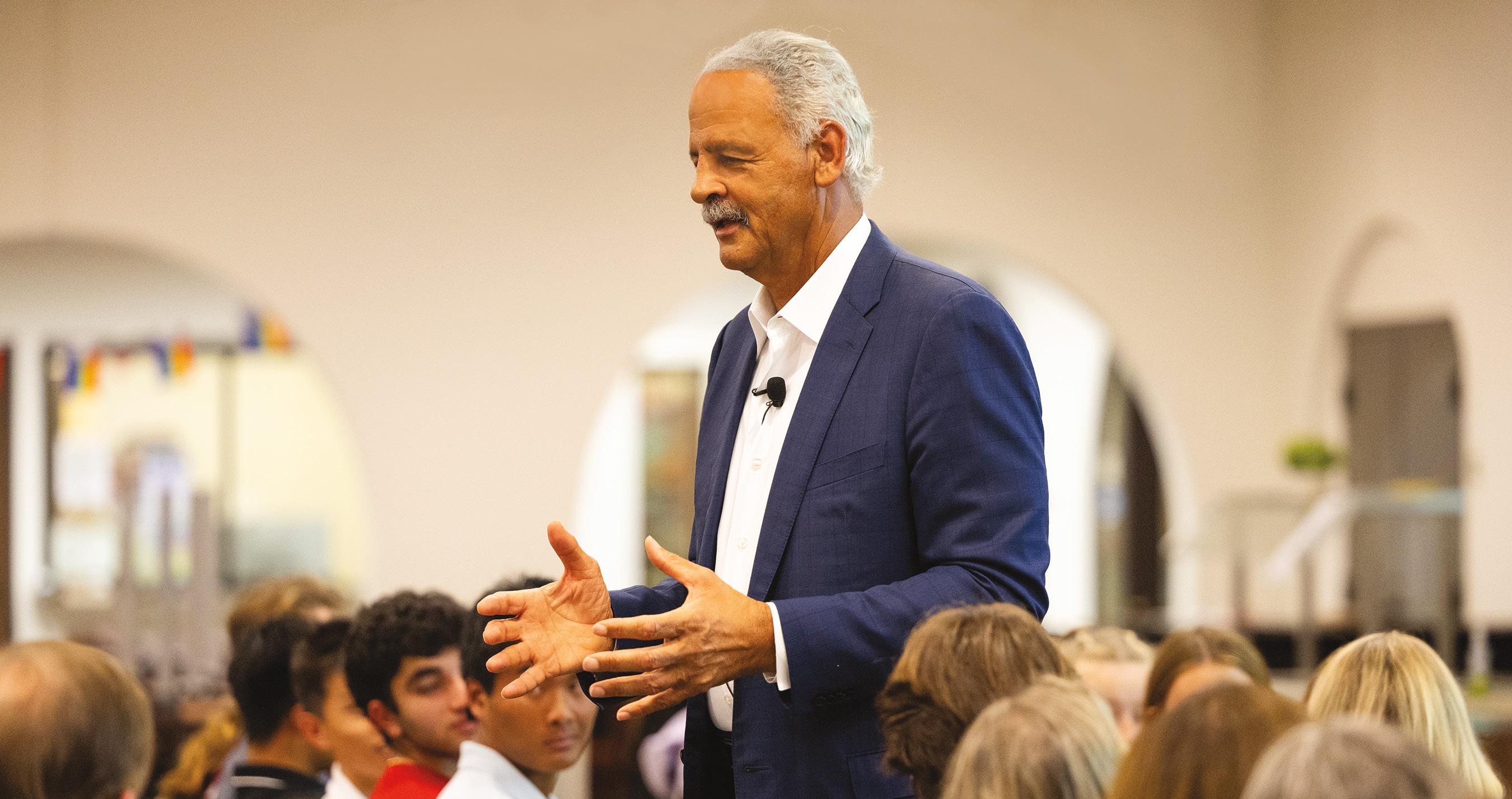
Do You Know WHO You Are?
By Cathy Morrison
That question is foundational to being a good leader, and Stedman Graham posed it to student members of the Lucky Ducklings Club as they kicked off their year of serving unhoused members of the local community. Graham’s guiding principle, “it doesn’t matter how the world defines you, what matters is how you define yourself,” is the cornerstone of what he calls “Identity Leadership.”
San Diego’s Lucky Duck Foundation has a mission “to prevent and alleviate the suffering of homelessness in San Diego County.” Executive Director Drew Moser shares, “We want to lead homelessness programs designed to have immediate impact; programs that are quantified, measured and understood and help people right now.”
Moser continues, “Lucky Ducklings is about engaging high school youth to help advance our mission, to go out and
volunteer, to learn about the issue, to develop their own programs and strategies, to get their friends involved, to help raise money if they feel so compelled.”
Graham drove to San Diego to give the student club representatives a leadership workshop in October. Moser notes, “Stedman has worked with Lucky Duck Foundation before, and we appreciate his insights. Students with these big hearts, who care deeply, who really want to go out and make a difference, that requires leadership.”
Among his 12 books is the New York Times bestseller “Teens Can Make it Happen,” which has been used in schools across the country. Graham says, “I love what the Lucky Duck Foundation is doing and how they’re developing a leadership club at this school. I support their mission of trying to get young people to help break the cycle of homelessness.” He adds, “I want to invest in young people, try to get them to
4

understand who they are. It’s the foundation for learning, taking in information and making it relevant to their talents and their skills. Basically, they have to have an identity for themselves. I think this work is very important so any time I have the opportunity to do it, I’m doing it.”
Senior Mia Gaspar and juniors Adelaide Kessler and Gabby Gaspar reflected on the opportunity to hear from Graham. The key message for Mia was, “I really have to love what I’m doing; that will help me stay focused and meet my goals. In terms of Lucky Ducklings, it will help me to help other people.”
“He mentioned how the things you do every day are tied into leadership. That was really powerful,” says Adelaide, who adds that it was surprising to hear that many people “don’t know who they are or what they should do with their lives.”
Putting things in perspective resonated
for Gabby, who relates, “I find myself getting slumped over work all the time and he brought it more into perspective that if you’re doing what you love, work doesn’t feel like work anymore. It made me grateful for the things I do love and making sure that I know what I love and being able to put my effort and energy into things that are most important.”
Adelaide notes, “Going to a school like Bishop’s, living in La Jolla, in San Diego, we’re so privileged, and I feel that being able to give back to the community—say I go to a Hunger Supper after I’ve had a horrible day—that just puts things into perspective.”
Making a difference in the local community is what brings the Lucky Ducklings together. Adelaide appreciates the foundation’s motto, “Share Your Luck.” Gabby concludes, “Homelessness is so much closer to our loved ones and our community than people think.”

University of Utah Professor Fall 2023 Mulgrew Poetry Series Guest
The English Department welcomed Paisley Rekdal on Nov. 6, 2023 for the fall installment of the Robert Mulgrew Reading Series. If you want to replicate the experience guests had as she opened her reading, visit https://westtrain.org. You’ll also see the history behind the poems. The cadence of Rekdal’s delivery evoked a train rumbling along the tracks, and students were taken through the work in a way that surprised and delighted them, opening them to the work in a new way.
Bishop’s English Teacher Adam Davis writes, “‘West: A Translation’ is particularly fascinating as it began when Rekdal was commissioned by the Spike 150 Foundation to write a poem commemorating the 150th anniversary of the transcontinental railroad’s completion. The result was the book: a linked collection of poems that respond to a Chinese elegy carved into the walls of the Angel Island Immigration Station where Chinese migrants to the United States were detained. ‘West’ translates this elegy character by character through the lens of Chinese and other transcontinental railroad workers’ histories, and through the railroad’s cultural impact on America.”
ROBERT MULGREW POETRY SERIES

A History Lover’s Dream, an Educator’s Gratitude
By Ron Kim

An overnight visit to the USS Carl Vinson prompts grateful reflection from Head of School Ron Kim.
On July 8, I joined 10 other “distinguished visitors” selected by the U.S. Navy to spend two days on the aircraft carrier USS Carl Vinson. The visitors were professionals in fields ranging from entertainment to business to education, getting an up-close view of the ship’s operations, including the final certification process for carrier pilots.
While retired Bishop’s history teacher Rich del Rio informed me of the Navy’s distinguished visitor program a few years ago, the roots of my interest stretch much farther back. As a kid, I remember waiting eagerly for the end of the month. My parents would hang long vertical calendars in the kitchen that they got for free from Korean restaurants. On one side, the calendar featured a traditional Korean scene. The back side was blank and offered a large canvas for me to draw scenes of naval battles from the Pacific Theater in World War II. I didn’t love every subject in school, but I soaked up anything related to naval history. The chance to spend two days on an aircraft carrier fulfilled a lifelong dream.
We began with a briefing at Naval Air Station North Island on Coronado. Sitting where the actor Jon Hamm sat in the film “Top Gun: Maverick,” we received a mini seminar on the modern Navy and the expectations for our visit. From there, we shuttled to the flightline and boarded a CMV-22 Osprey for our flight

out to the carrier. The Osprey flies like a plane, takes off and lands like a helicopter, and has none of the comforts of commercial aviation. The ramp in the back of the plane remained open throughout our one-hour flight a mile above the ocean. The two sailors sitting next to the opening attached only by a cable seemed untroubled.
Upon landing, we met the communications team and moved quickly to a briefing on flight operations. The deck of an aircraft carrier is one of the most dangerous places in the world, so naturally I listened intently as the instructors explained how to watch takeoffs and landings safely. Our protective vests were equipped with handles on the back so that we could be grabbed and moved into safety if needed. In such an event, we were advised not to take offense.
Walking through a maze of hallways, up and down steep and narrow steps, we found ourselves on the flight deck within 25 feet of an F/A-18 preparing to be catapulted. Though our ears had two layers of protection, we could hear the high-pitched strain of engines as we climbed closer and then we were right there. We felt first the heat coming off the jet blast deflector, then heard the roar of the engine as the arresting arm released and the jet went from zero to 150 miles per hour in 150 feet.
Meanwhile at the aft, planes were landing, tailhooks grabbing cables, bringing tons of metal to an abrupt, controlled stop. Flight operations went on for hours, even into the
darkness of night to certify pilots on their final tests. We watched from the bridge and then from air control. We were astonished and grateful for the precise operational orchestration executed by teams of people not much older than Bishop’s seniors.
A few decks and many narrow stairways below, we met the chief dentist on the Vinson. One of four full-time dentists on board, he explained his lifelong devotion to the service. Plucked from the ocean by a naval vessel as a two-year-old when his family fled the communist invasion of Vietnam, he has spent much of his life giving back to those who saved him. His dental assistant saw the Bishop’s “B” on my shirt and asked if she could talk to me about how her daughter could apply. I stayed behind, offered some quick information and encouraged her to reach out!
Up and down more steps, down long and narrow corridors, we found ourselves in the mechanical area where jet engines are serviced continually. After we listened to one of the mechanics discuss an F/A-18 engine, a flight instructor heard that I was on board and approached me and asked about Bishop’s for her son. As a single mom, she wants to find a school where her son will be surrounded by great people.
We next had the privilege of dining in the captain’s quarters along with some staff guests. Among them were a former student of mine serving as the judge adjutant general on board, and a current Bishop’s parent who

serves as the assistant head of the ship’s security team. The Bishop’s parent talked about his gratitude for the education that his son is receiving and for the number of people at School who have helped his son during his many months on deployment. At the beginning of our tour, much of the conversation among the distinguished visitors was about flight operations and then eager questions for the Hollywood writers and producers in our group. By the end of the dinner, Bishop’s became the focal point of conversation. Unfamiliar with hearing such enthusiasm about a school, they asked, “What is up with Bishop’s?”
I happily shared stories about Bishop’s, moved by what it means to military families who have children here or who seek to enroll them. I think about the thousands of dedicated service members on the Vinson and the thousands of others on other ships and bases. I think about what we owe to them. I imagine a time when we can devote financial aid resources specifically to the children of service members. What measure of gratitude can we extend to people who do so much for us?
My visit to the USS Carl Vinson was a full-circle experience—from drawing pictures of naval battles on the back of calendars, to majoring in history, to a rewarding career in independent schools, and then onto the deck of an active carrier where I could say thank you and ask myself, “What can I do for them?”
7 Stars at Knight, Big & Bright A History Lover’s Dream
Bishop’s Team Takes Robotics Know-How into the ‘Real World’
By Ashley Mackin-Solomon
This article first appeared in the La Jolla Light on Nov. 10, 2023. Reprinted with permission.
Embracing the universal language of robotics, a team of students from The Bishop’s School in La Jolla is putting a summer experience in Bordeaux, France, to use in a drive to get back there next year.
The team, called Knight Sky as a nod to Bishop’s knight mascot, competed against (and in some cases, alongside) other robotics teams from countries including Mexico, Australia, Brazil and more in Robo Cup 23.
The local squad participated in the Rapidly Manufactured Robot Challenge, in which the students were tasked with developing inexpensive robots that could be used in various crises or disasters such as earthquakes, nuclear meltdowns or building collapses. Teams had to design and test robots that could get into small spaces to do things such as open doors, look for survivors and check for damage.
“It is as much a competition against a problem as it is a competition against the other teams,” said Knight Sky faculty advisor Marcus Jaiclin.
Jaiclin was joined by fellow Bishop’s teacher Lani Keller in the July 4-10 excursion to France. The team consisted of Bishop’s students Mia Gover, Millan Kumar, Sienna Li, Audrey Lin and Ryan Zhu.
“It was an event that has a real-life purpose,” Audrey said. “I really liked this event [because] … we took the coding we learned in our computer science classes and took it out of the classroom and applied real applications.”
The Knight Sky robot, she said, was the size of a cereal box and had to navigate terrain such as sand and stairs, read signs that might indicate the type of crisis it is facing, and complete dexterity exercises such as picking up a small object and reach small spaces that a human can’t.
One challenge in particular was navigating stairs that were deeper than the robot was tall.
“That was something we struggled with,” Audrey said. “But it was really cool to see other teams that had successful arms that
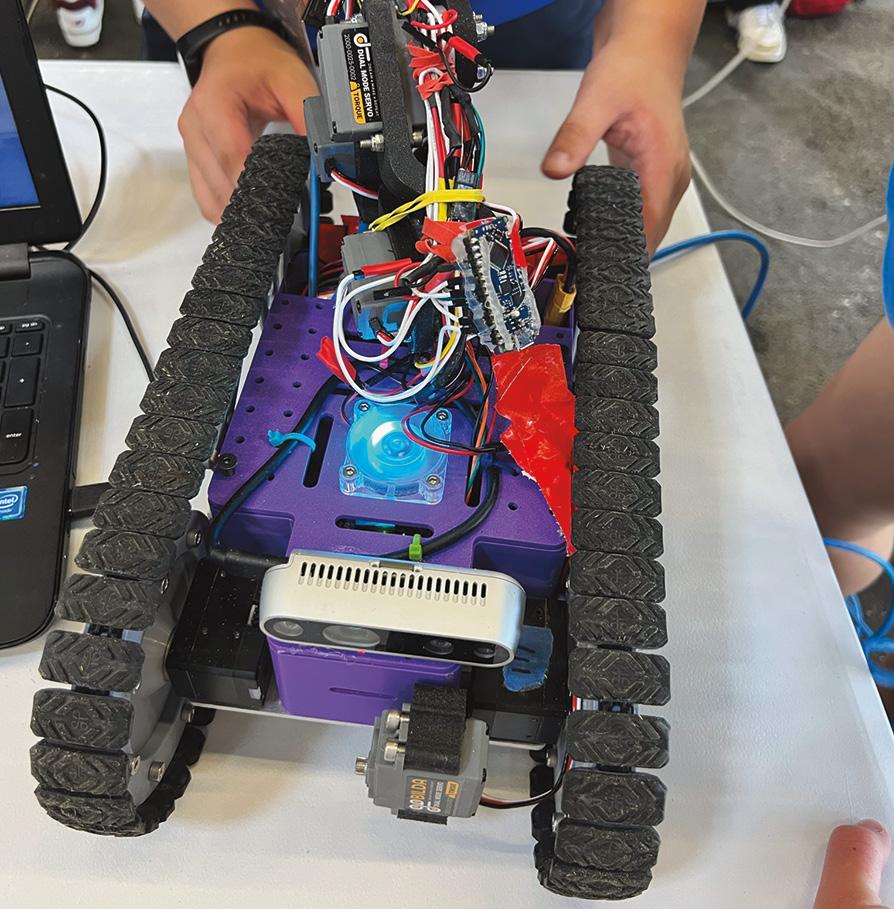
KNIGHT SKY
“We got to work with other people’s robots—the robots we had been admiring and thinking were so cool over the previous few days,” she said. “We worked together and found innovative solutions we would not have come up with by ourselves.”
helped push them up. … We saw different maneuvers that the robot could do to get over the stairs.”
Another challenge was the potential for grains of sand getting into the gears and jeopardizing the robot.
Jaiclin said the terrain was designed to mimic what the Federal Emergency Management Agency sees in real disasters.
“They have built all these test elements based on FEMA needs,” he said. “So standard test methods have been to determine whether the robot can achieve these methods and therefore be helpful in a disaster response.”
Knight Sky didn’t win, but Audrey said she learned a lot about how the team could improve its designs for next year.
“What I really like about robotics
competitions is they are open-source—we can access what other teams have done, we can look at the designs and the code they made,” she said. “So we could look at what other teams have done and what strategies we might want to implement.”
The intent is for the team to continue to participate in the Robo Cup and other robotics competitions in the future.
“I found this team to be very adventurous and creative with their problem-solving path and engage in that trial-and-error process,” Jaiclin said.
An added bonus was engaging with the international teams as part of the competition.
“I can’t think of any other high school activity that I could say we had dinner with the Brazilian team to talk robots,” Audrey said. “I think that is such a cool experience … to work with people from different countries that are also interested in this and might have a completely different take or unexpected take than what we had.”
She described the event as part competition and part exhibition for the various teams.
“There was a soccer-playing robot and a huge robotic spider on display,” she said. “So walking through the building was so awesome.”
Audrey has been in robotics since elementary school, largely because she noticed she would be the only girl. “I remember I was the only girl of 40 boys,” she said with a laugh. “I remember there was a boy that didn’t want to partner with me because he didn’t think I’d be a good programmer. But we ended up winning the competition.”
She soon joined First Lego League to participate in competitive robotics and said she enjoyed the building and coding aspects. “I just knew it was something I wanted to do in the future.”
Audrey said the Robo Cup reinforced her love for the growing field.
“There are so many applications that are coming out for robotics,” Jaiclin said.
Bishop’s Robotics in the Real World 8
STUDENTS COMPETE IN FRANCE TO DEVELOP AN INEXPENSIVE ROBOT THAT COULD BE USED IN A CRISIS OR NATURAL DISASTER.
“What I like about Robo Cup is that it is not game-based or simulation-based. It’s not teaching you the skills you will eventually use, it’s actually using the skills because we are doing the real thing. These are robots that could be used in the real world. We’re taking the things we are learning and bringing it to life.”
Once the competition was over, teams were brought together to complete a task, Audrey said. Knight Sky was paired with teams from Hungary and Australia.
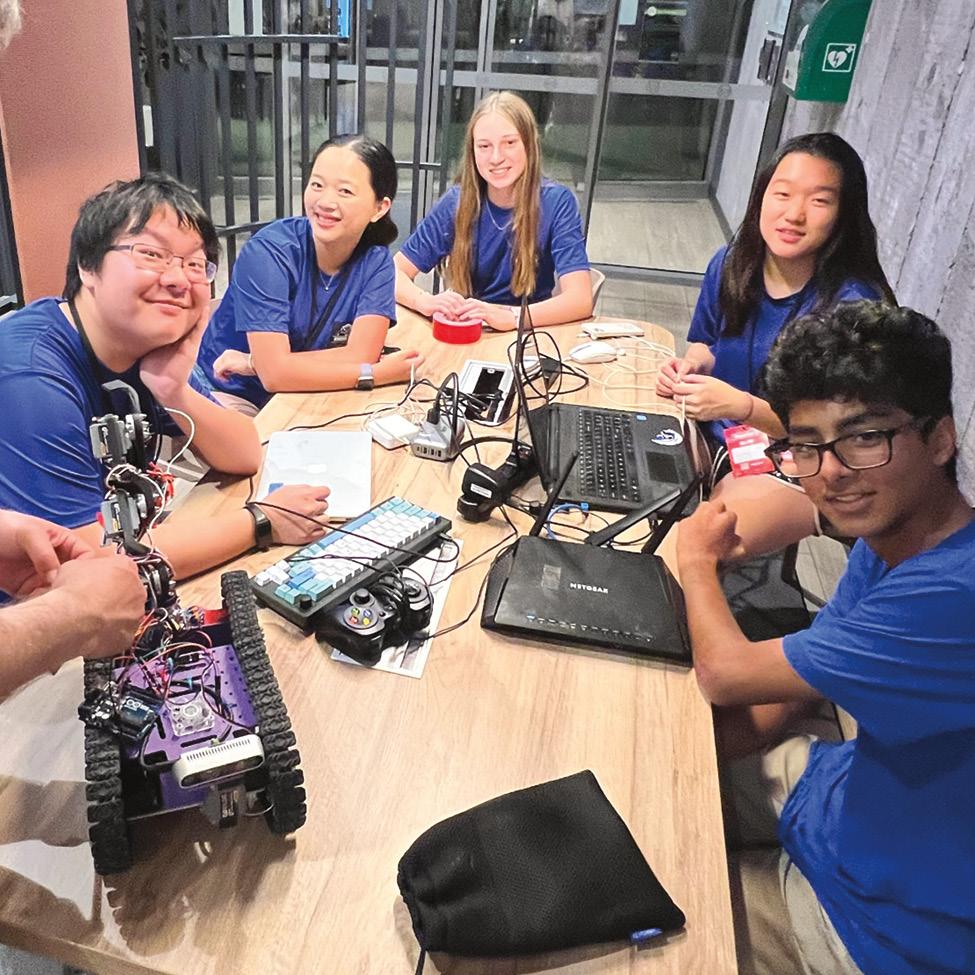


9 Bishop’s Robotics in the Real World
By Jared Scott Tesler
Modeling Diplomacy and Global Citizenship
In December 2023, led by co-SecretaryGenerals Sydney Chan ’24 and Marina Khoury ’24, The Bishop’s School’s Model United Nations (MUN) academic team hosted its ninth session—its largest to date—of the KnightsMUN Invitational Conference, the largest high school conference of its kind in San Diego County. Participants comprised 200 delegates from 15 schools throughout San Diego, Los Angeles and the San Francisco Bay Area.
In total, 25 students represented Bishop’s at this year’s conference, running sessions, leading debates, assigning speakers, evaluating performances and position papers and presenting awards. Chan and Khoury co-chaired the International Court of Justice. Ava Bradley ’24 chaired the Security Council. Muping “Selene” Wang ’25 chaired the UN High Commissioner for Refugees. Emmie Kao ’25 chaired the UN Office on Drugs and Crime. Sofia Hayden ’25 and David Lai ’25 co-chaired the UN Environment Programme. And Nason Li ’25, Dylan Navarrete ’24 and Jonas Pfefferman ’24 co-chaired the Joint Crisis Committee. Topics for discussion, hand-selected by students, included Guantanamo Bay, Haiti, the Mediterranean refugee crisis, drug trafficking in Southern Asia, plastic pollution and roarin’ Chicago.
History teacher and assistant coach of MUN Abby Perelman, who participated in MUN during her high school days at Pacific Ridge School, says attendees often cite the impressive organizational and leadership skills of Bishop’s MUN team leaders—known as the secretariat—as a reason why they return to the conference year after year.
“Other schools and students in the region are drawn to KnightsMUN because we’ve built a reputation for exciting committee topics, engaging sessions full
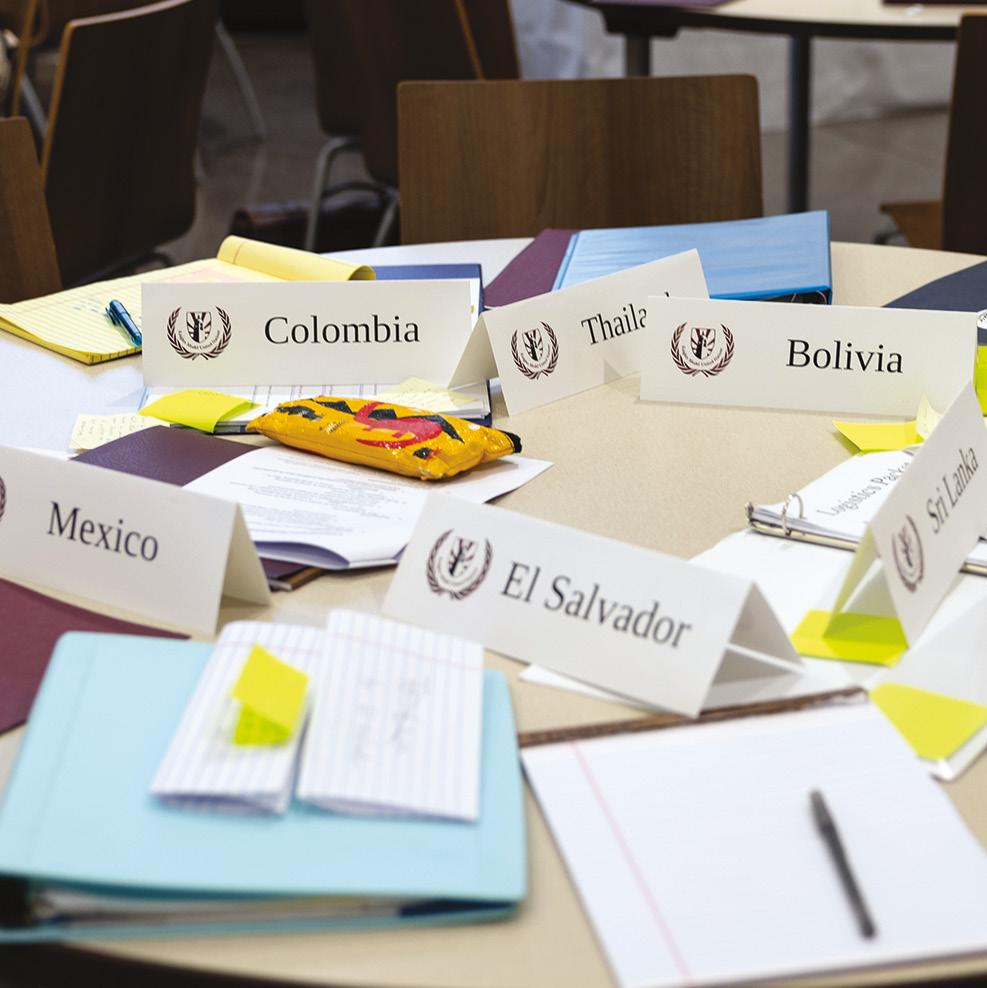
of debate and collaboration, and a strong cohort of student leaders who help effectively and passionately organize and run our committees. We’ve also been lucky enough to host some inspiring speakers for our opening ceremonies,” adds Matthew Valji, history and social sciences teacher and Bradley A. and Cathy C. Geier Chair in History, who serves as head coach of both MUN and Speech and Debate as well as vice president of debate of the San Diego Imperial Valley Speech League.
This year’s opening ceremony featured remarks by guest speaker Joy de Beyer, mother of Bishop’s alum Zoe Kirsh ’11 and retired health economist at the World Bank, an international financial institution that provides loans and grants to the governments of low- and middle-income countries for the purpose of pursuing capital projects. De Beyer, a former Rhodes Scholarship recipient who holds a doctoral degree in economics from the University of Oxford, shared a series of memorable experiences throughout three decades of working to enhance capacity to improve health systems in countries around the world.
Chan also addressed those in attendance, citing her greatest takeaway from the pandemic, marked by lockdowns of varying stringency, the Jan. 6 United States Capitol attack, and xenophobia and racism against people of East Asian and Southeast Asian descent and appearance: “Though our world grows increasingly divided, with conflict seemingly seeping from every corner of the globe, we must all remind ourselves that the Earth is not composed of nations and borders but rather of humans and hope.”
In her speech, Chan, who serves as editor-in-chief of student publications “The Tower” and “Globe,” goes on to say, “Behind every flag stands the story of a people, dedicated to the preservation and betterment of not just their lives but of those who will come after them. It’s this understanding that can lead to the type of world where productive conversation and illustrious debate can flourish. And it’s with this mindset that we’re better able to support our friends, family, peers, and even those we don’t know yet, to help carry whatever load is resting on their shoulders.”
Whether they choose to attend lunch meetings or local and large-scale conferences, Valji notes, one thing is for sure: MUN participants inevitably gain a global perspective while discussing such universal—and nuanced—topics as the environment, humanitarian crises and issues, international affairs, public health and war and conflict.
“MUN helps students learn more about the world and understand the humans within it,” he says, mentioning the team’s big win as Best Large Delegation earlier this school year at UC San Diego’s TritonMUN conference. “When a student has to run an entire committee on the refugee crisis in the Mediterranean, for instance, they’re going to
Modeling Diplomacy 10
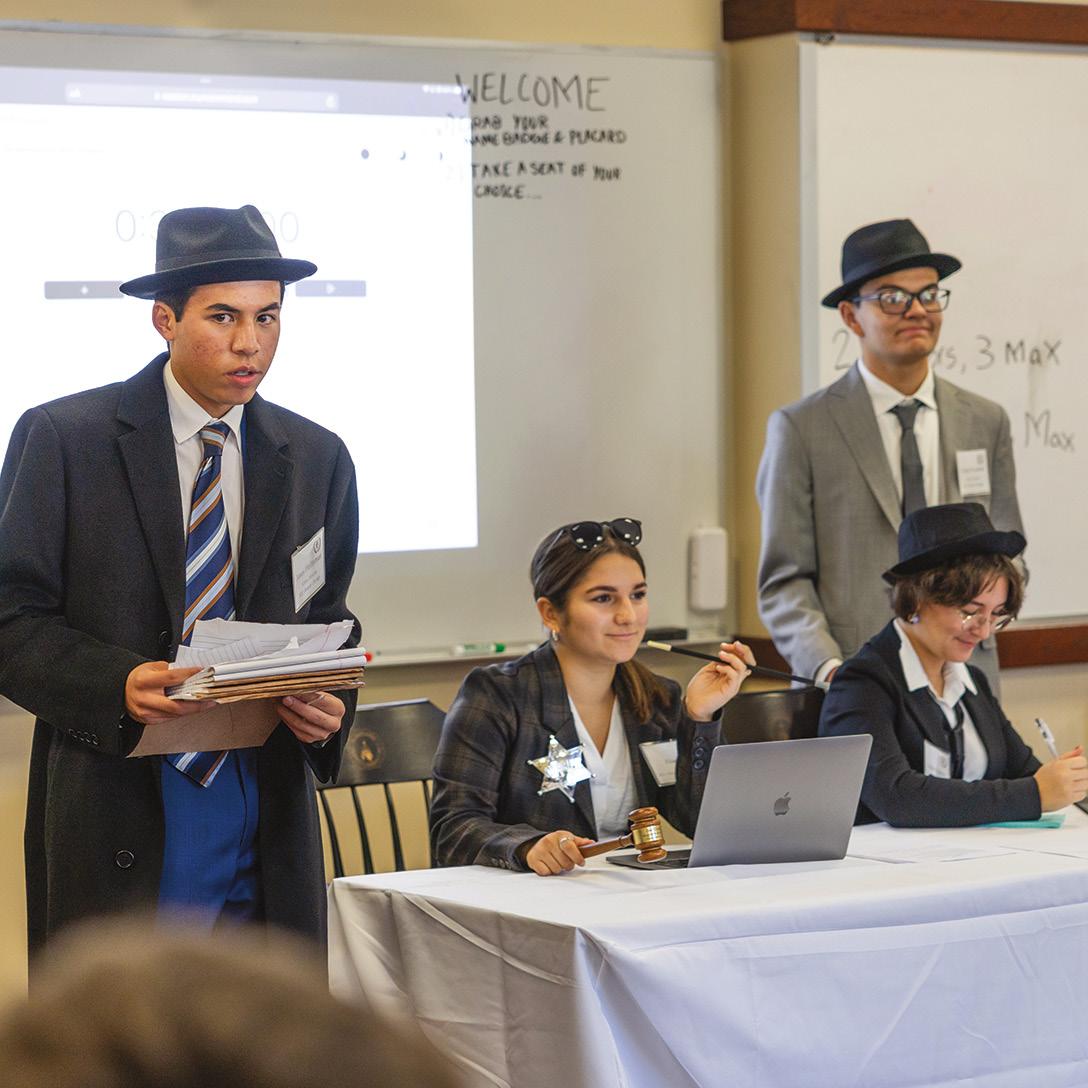
understand a lot more about what’s happening in the Middle East, North Africa and Europe and what that means for the world. I see it as part of the general mission of the School to create global citizens and real-world influencers.”
Students like Khoury, who has participated in MUN for the past six years and chaired last year’s KnightsMUN Prison Reform Committee, are living proof. “The team’s presentations helped me build an understanding of geopolitical events, historical connections, inter- and intra-regional dynamics, and international relations,” she says. “I’ve come to understand MUN as one of the most wide-ranging academic teams at Bishop’s in terms of developmental impact. In addition to learning more about the world that surrounds and precedes me, I’ve developed creative, critical and collaborative skills by examining and coming up with solutions to pressing global issues alongside my peers.”
The program has had lasting impacts, too, with many past participants going on to take part in MUN at their respective colleges and universities—like Dylan de Waart ’15, an alumnus of Harvard University and founder emeritus of Recover, an innovative telehealth platform that makes addiction treatment more effective, accessible and affordable, and Ellie Hodges ’22, a student at Columbia University in New York City, which hosts its own conference and exposition attended by Bishop’s regularly.

“A large percentage of these students continue this work—negotiations, logistics, international relations—in college or in their careers. There’s a lot of cross-applicability,” Valji says. “Our hope is that KnightsMUN helps students—both at Bishop’s and throughout our region—to become more educated about critical global issues and to develop persuasive writing and speaking skills, which will allow them to have a compassionate perspective of the world and make positive changes in the world.”

Alumni Careers in Athletics LEE JEN KINS ’95
WE SAT DOWN WITH A HANDFUL OF BISHOP’S ALUMS WHO HAVE CARVED OUT SUCCESSFUL CAREERS IN SPORTS, FROM COACHING AND SCOUTING TO MEDIA AND SALES. THEY SHARED THE IMPACT OF THE BISHOP’S EXPERIENCE ON THEIR CAREER TRACK, AS WELL AS LESSONS FOR CURRENT BISHOPIANS WHO MIGHT HOPE TO FOLLOW IN THEIR FOOTSTEPS.
By Zach Jones ’01

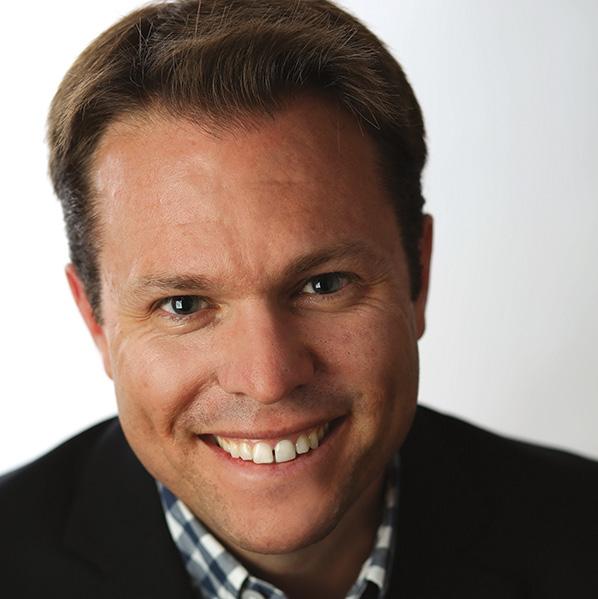
ALUMNI IN ATHLETICS
Lee Jenkins ’95
Following his graduation from Vanderbilt University, Lee wrote for the Colorado Springs Gazette, Orange County Register and The New York Times before joining Sports Illustrated in 2007. He currently works for the L.A. Clippers as Vice President of Basketball Affairs.
Nick Booker ’00
Nick played varsity basketball at Bishop’s before continuing his playing career at Davidson College. He is in his first season as the head men’s basketball coach at Cal State San Marcos, but before this, he held assistant coaching positions at UC Irvine, Eastern Washington University, Davidson College and most recently UC San Diego.
Justin Horowitz ’09
Justin joined the Boston Red Sox organization as a baseball operations intern during the summer of 2012 following his junior year at Georgetown University. He worked with the club for almost 12 years in a variety of roles within their scouting department. He joined the Pittsburgh Pirates as the club’s director of amateur scouting in November 2023.
Bennett Sexton ’10
Since graduating from Bishop’s, Bennett has held a variety of positions throughout the sports industry, beginning with an internship at IMG while he was a student at the University of Missouri. He also worked at the Wasserman sports agency and in event production before joining the San Francisco 49ers, where he is currently Director of SBL & Group Sales.
Cameron Ezeir ’19
Cameron earned his bachelor’s degree in broadcast journalism from Syracuse University in May 2023, and joined WFRV-TV (CBS affiliate in Green Bay, WI) in July, where he’s a reporter and producer for the station’s coverage of the Green Bay Packers and other local sports.
WHEN DID YOU KNOW YOU WANTED TO WORK IN SPORTS?
Cameron Ezeir
Sports Reporter for WFRV (Green Bay, WI)
During my junior year at Bishop’s, I knew I wanted to be in sports media, knew I wanted to be in sports broadcasting. I love to talk about sports—I love to talk people’s ears off, so I thought ‘OK, maybe I could be good at that.’ So I joined the newspaper at Bishop’s thanks to retired Associate Director of Athletics Andy Koczon; he mentored me throughout that process. He proposed an idea called “Meet the Coaches” or “Meet the Team Captains,” so I made a YouTube channel. Starting that six years ago really pushed my love for doing this.
Bennett Sexton
Director, SBL & Group Sales for San Francisco 49ers
The San Diego Chargers were my first love, and there comes a time when you realize you’re not going to be a professional athlete— you have to come to grips with that pretty early when you’re 5’9” and 155 pounds. Sports was the one thing that really kept my attention and I had a genuine passion for.
Justin Horowitz
Director of Amateur Scouting for Pittsburgh Pirates
As a young kid, I knew about baseball from watching Baseball Tonight, SportsCenter, reading books. The roster management piece always fascinated me, even as a kid playing video games and things. It was the space I always knew I wanted to go into, and I was lucky enough to break in and continue to work in the sport.
Alumni Careers in Athletics 12
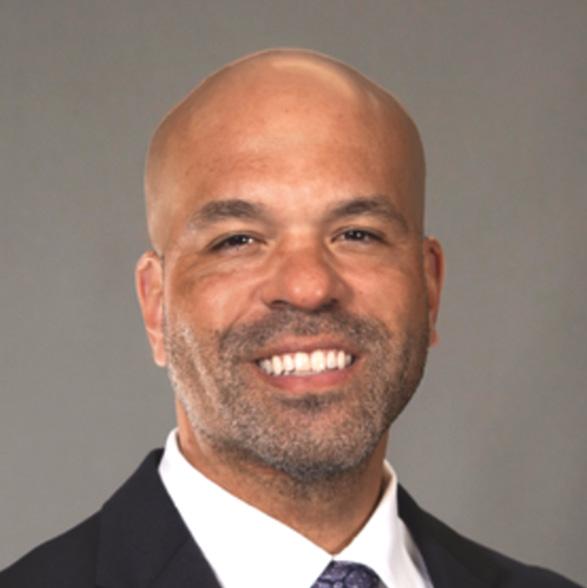
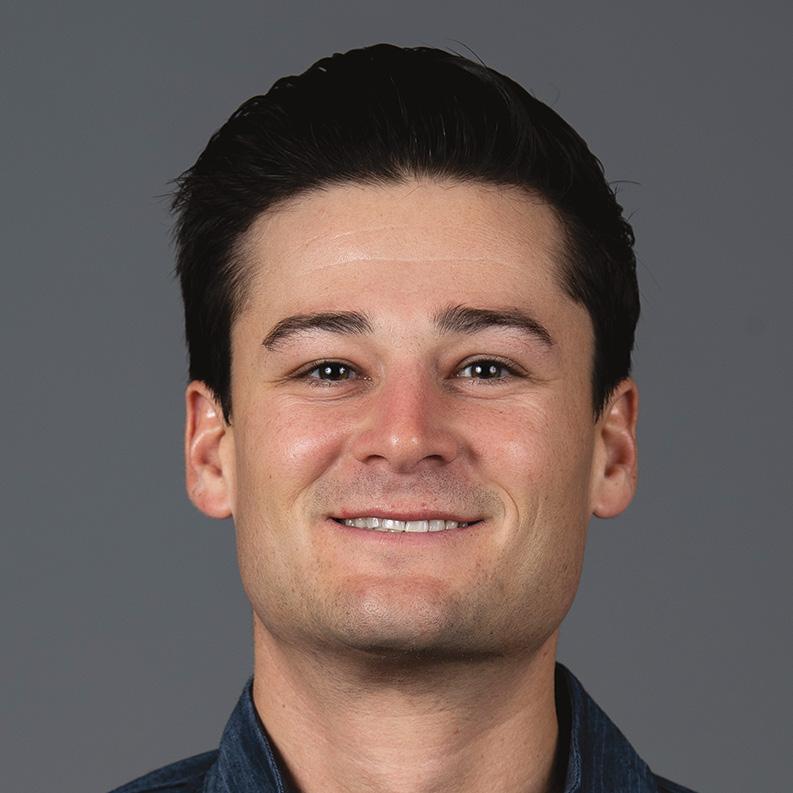



Lee Jenkins
Vice President, Basketball Affairs for L.A. Clippers; formerly Lead NBA Writer for Sports Illustrated
Probably when I was really little, and I’d sit on the right-field line at Jack Murphy Stadium and watch Tony Gwynn play right field. That was my first experience loving a team. And then when I went to Bishop’s, I was in seventh or eighth grade, and I decided that I wanted to be the next Bob Costas—that was my goal. I’d actually wear this NBC Sports sweatshirt around.
Nick Booker
Head Men’s Basketball Coach for Cal State San Marcos
I didn’t know I wanted to work in sports, other than playing professionally. My aspiration was to get paid to play basketball. It wasn’t until two years after graduation from Davidson that I figured out I wanted to have a career in coaching. Initially, my focus was solely on pursuing a career as a professional player, but as I gained more experience and perspective, I realized that coaching was where my true passion and potential lay.
HOW DID BISHOP’S IMPACT YOUR JOURNEY?
Cameron Ezeir
My junior year, Bishop’s hired Associate Director of Marketing and Communications Jen Jordan and I can’t thank her enough for her impact on me, because my entire senior year, she set everything up. She was behind the camera when I set up interviews, and whenever I wanted to call play-by-play for
a sport, she was the one who coordinated it. To say that Bishop’s spearheaded my sports media career would be an understatement. It did everything for me.
Justin Horowitz
The challenging academic environment at Bishop’s prepared me to hit the ground running once I got to college, which ultimately allowed me to sit down in an interview process for a job in baseball with thousands of applicants. I don’t know if I would have qualified if I hadn’t been as well prepared as I was coming into college.
Lee Jenkins
A friend of mine was writing sports for the La Jolla Light, so I started writing for the Light and I wrote for them freshman through senior year. People at Bishop’s were amazing about it. Jim Fales, the water polo coach, used to give me incredible access, and there was just a lot of support in the community. They would hang clippings from various stories in that glass case outside the chapel. By the time I was done with that experience, it was so rich for me that I knew my future would be in sports and probably sports writing, which it was.
Nick Booker
Bishop’s had a profound impact on my journey, shaping me into a resilient and determined individual. As a student at Bishop’s, I faced a daily commute from Oceanside to La Jolla, which required me to wake up at 4 a.m., an early morning routine that would begin with a walk to the bus stop, followed by a bus ride to school. I would stay late due to my
involvement in basketball, which meant by the time I returned home, it was often 8 or 9 p.m. This experience instilled a deep sense of resiliency and discipline. It taught me that success often requires hard work, sacrifice and perseverance through adversity. These continued to be valuable assets as I navigated the complexities of my working life; they became my guiding principles, reminding me that with dedication and unwavering commitment, I could overcome challenges and achieve my goals, no matter how daunting they may seem.
WAS THERE A MOMENT WHEN YOU KNEW YOU COULD MAKE A LIVING IN SPORTS?
Cameron Ezeir
My junior year at Syracuse, the ‘rule’ was that you don’t do a studio show as a junior—you have to wait your turn. I think this was for soccer, and all three of the top seniors had traveled for the football game that week. They said, ‘We need you,’ so I hopped on that studio show and it was a blast. Just that belief that people put in me—that was the moment where I said, ‘Have confidence in yourself, because other people do.’
Bennett Sexton
With the 49ers, it was a right place, right time deal. They were re-working their sales department and it gave me an opportunity to give sales a try. I love people, and talking to people, and I was fortunate that they took a chance on me. I realized that my day-to-day routine was just talking to people. Learning how to talk to a variety of different people was something I loved.
13 Alumni Careers in Athletics JUSTIN HO R OWITZ ’ 09 NICK BO O KER ’ 00 BENNETT S EXTON ’ 10 CAMERON EZEIR ’ 19

Justin Horowitz
I wouldn’t say there was a single moment when a lightbulb went on, but I think it was a gradual understanding during my first summer as an intern. There are skills that I don’t have because I didn’t play professional baseball, but that presents an opportunity for me to learn and ask questions of those around me.
Lee Jenkins
After my sophomore year at Vanderbilt, I got an internship at The Boston Globe, so that’s probably the easy answer. The real answer is when you write and you feel sentences coming out and you read it back and say, ‘That’s really fun. I didn’t really do any work there—I just enjoyed it.’ When you can spend eight or ten hours on a piece at your computer, and you don’t hate it—the time just slips away.
Nick Booker
It all began when one of my former assistant coaches brought me on as a volunteer assistant coach at UC Irvine. At that point, I was five years into various coaching positions, and honestly, you’re not really making a ton of money at that stage in your coaching career and that’s when things start to get tough. I made a commitment to myself that I was going to give it two years, coaching in a volunteer role, with the hope of eventually landing a full-time opportunity. Two months into my volunteer coaching gig, luck smiled upon me. An individual left the program; the head coach saw my dedication and hard work, deciding to promote me into a full-time director of operations position. This was the turning point I had been hoping for, and it gave me the stability and opportunity I needed to pursue a career in sports. The story doesn’t
end there; a year later, I received another promotion, to assistant coach. From there, my coaching career took off, and I knew I could indeed make a living doing what I loved in the world of sports.
WHAT ADVICE WOULD YOU GIVE A CURRENT BISHOP’S STUDENT WHO WANTS TO WORK IN SPORTS?
Cameron Ezeir
If you love it, go for it. And if you’re not sure, try it out, see what happens, and forge your own path. When I first got into this, all I wanted to do was play-by-play. Then I got to Syracuse, and I wrote for a blog, I worked for two radio stations, two TV stations, did studio shows. I filmed, I edited, and you don’t realize how you’re going to love so many other things until you try them.
Bennett Sexton
Don’t get intimidated, especially when you go to a place like Bishop’s. Everybody is still figuring it out, whether they act like it or not. Keep an open mind, and understand all the different departments and avenues that exist within sports.
Justin Horowitz
Sports is such a competitive field, so to be able to land an opportunity, we have to be able to separate ourselves. Take advantage of the opportunities that Bishop’s provides to learn and try new things. Build skills that you may be able to use for the rest of your life, whether it’s learning another language, or computer programming or technical skills that students at other schools might not have access to.
Lee Jenkins
Look for opportunities to start early. If you want to be a doctor, or a lawyer or private equity for example, you can’t start doing that really young. In sports, you can. You can be a student manager. So much of my life started with walking in those doors at the La Jolla Light. People will let young people try those things, whether it’s a student newspaper or student radio station or it’s working for a team.
Nick Booker
First and foremost, recognize that learning time management is crucial. At Cal State San Marcos, one of the initial lessons I teach to our scholar-athletes is the importance of effective time management. Bishop’s is known for its academic rigor, and the ability to efficiently manage your time is not only valuable during your college years but will also serve you well throughout your life. My capacity to handle time has been greatly influenced by both successful and unsuccessful experiences dating back to high school. So, develop strong time management skills early on, as they will undoubtedly play a crucial role in your journey toward a successful career in the world of sports.
Alumni Careers in Athletics 14
FALL ATHLETICS SEASON UPDATE
By Jen Jordan
Bishop’s Secures Two CIF San Diego Section Runner-up Titles and Four League Championships
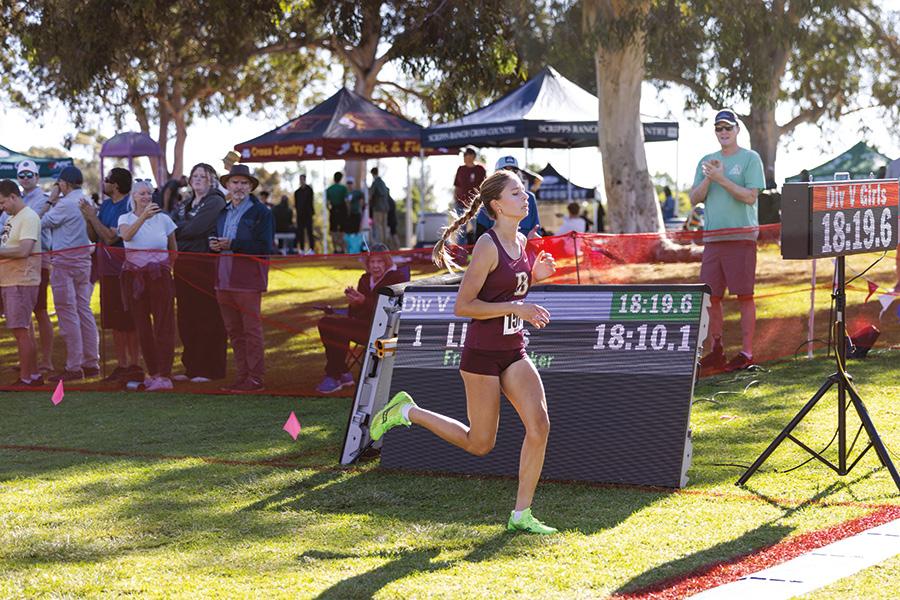
Bishop’s Girls’ Golf was the CIF San Diego Section Division I runner-up. Ayanna Hickey ’26 finished third at the CIF State Division V Cross Country Championships and second at the CIF San Diego Section Division V Cross Country Championships. Meanwhile, Football, Girls’ Golf, Girls’ Volleyball and Boys’ Water Polo were crowned league champions. Ayanna was the Division V conference champion runner-up and also had a stellar race at the CIF Division V Cross Country State Championships, placing third and setting a new school record (18:20).
Football secured a Coastal League championship with a 27-0 win over Santa Fe Christian. The Knights won seven straight games to close the regular season and finished the year 8-4, advancing to the CIF Division II quarterfinals.
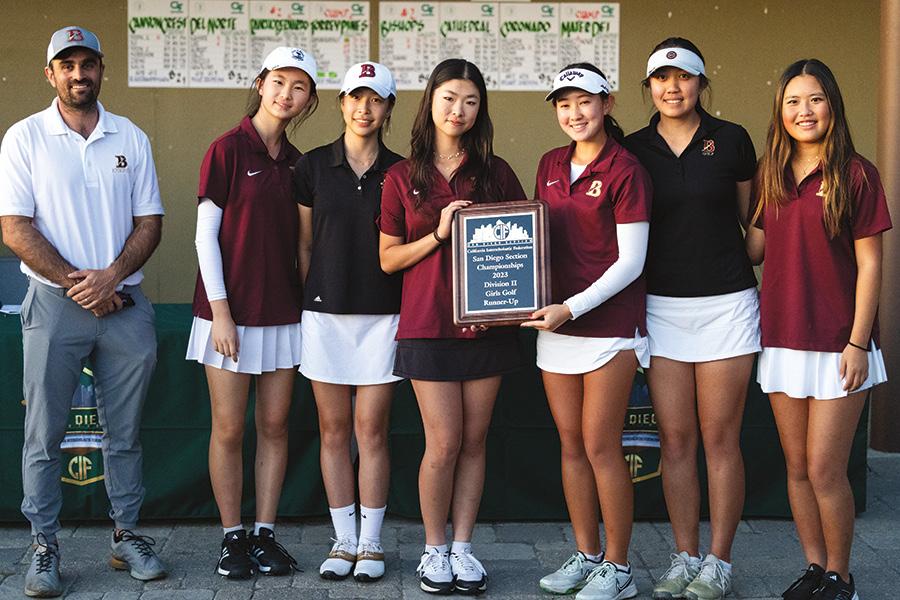
Girls’ Golf won the league championship with a 79-stroke win over second place in the only 18-hole tournament on the calendar. The Knights were CIF Division II runners-up, with Lucy Yuan ’24 finishing second overall. She was named to the All-CIF first team. Sophia Guan ’24, Renee Wang ’24, Joyce Wu ’25 and Lucy secured regular season honors, with Sophia and Lucy making the All-Coastal League First Team, while Renee and Joyce made the second team.
Girls’ Volleyball posted an undefeated Coastal League season, with a School-record four Knights earning All-Coastal League First Team honors (seniors Anna Balsdon, Kaia Grieve, Nalani Muniz and Matsa Shi). Freshman Kasia Zwierzykowski was selected for the second team.
Boys’ Water Polo earned a share of the Western League title with Cathedral Catholic and La Jolla, going 4-2 in league contests.
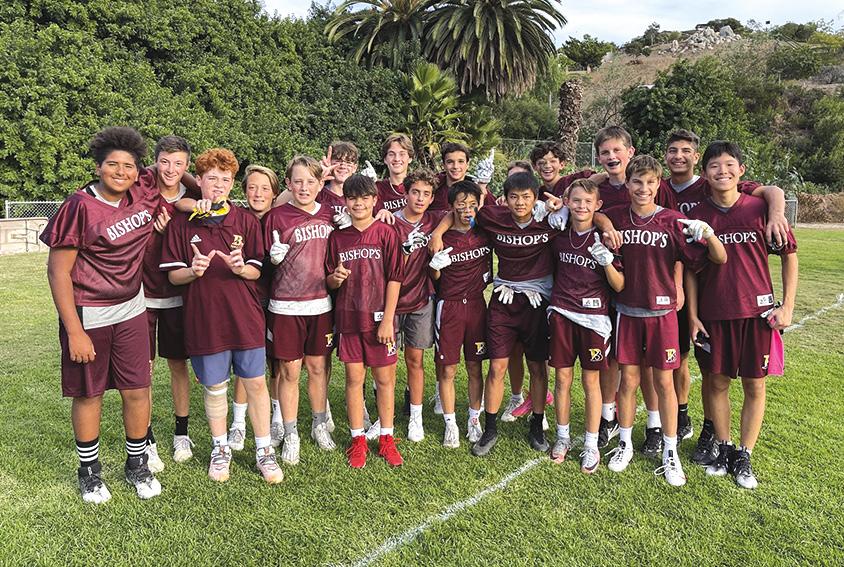
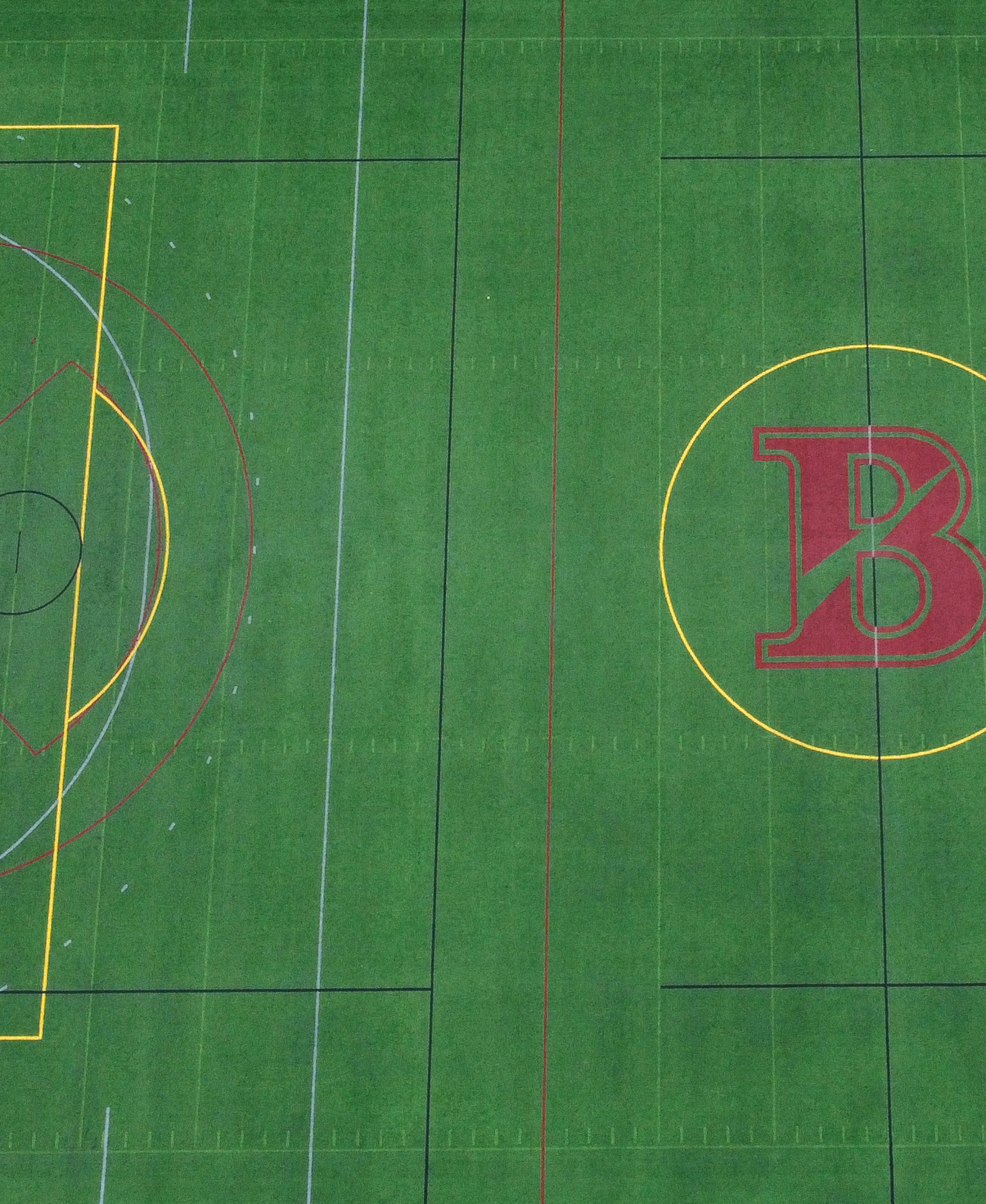
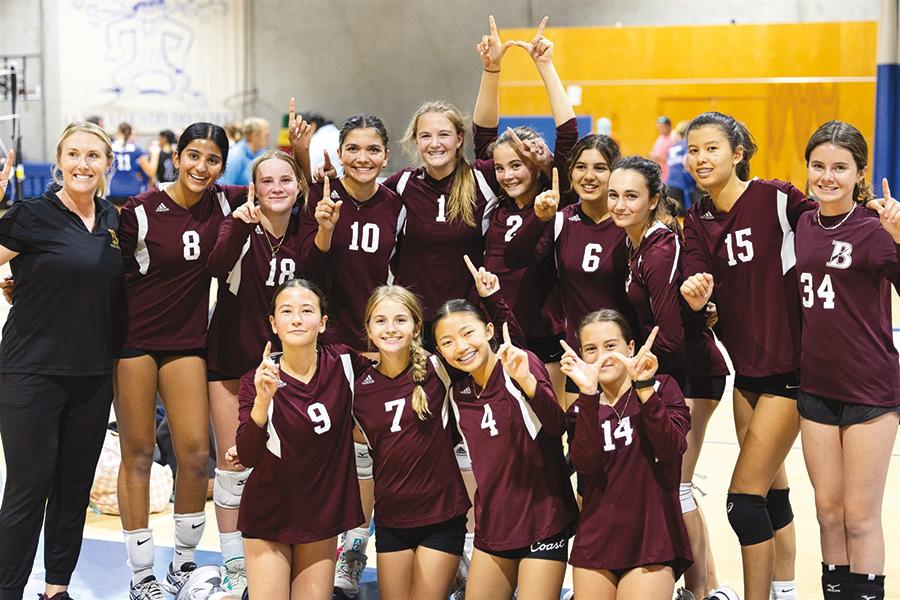
Bishop’s Middle School fall season was also a success, with our maroon teams bringing home three South Coast Middle School League (SCMSL) championships. Boys’ Cross Country finished first in every meet, including the championship. Flag Football beat Christian 21-0 in the SCMSL South Division Championship. Girls’ Volleyball beat La Jolla Country Day 2-0 for the conference crown.
Go Knights!
15 Fall Athletics Update
FRIDAY NIGHT LIGHTS
Bish Bowl, a beloved fall tradition, kicked off Reunion Weekend 2023. Organized by the Parents’ Association and the Athletics department, students, families, alumni and prospective families enjoyed an afternoon and evening of festivities that included a black-out dress theme; BBQ and games, a photo booth, face painting and golf cart decorating on the Quad, a student visual arts exhibit in EBS dining hall, and live music performed by Bishop’s Jazz Combo. Athletics contests throughout the evening featured JV and Varsity Boys’ Water Polo, Varsity Girls’ Volleyball, Varsity Girls’ Field Hockey, JV and Varsity Football teams. Bishop’s Dungeon gathered the crowd in front of Rohr Terrace at 5:45 p.m. to lead the community in the Bishop’s cheer and then led the throng on an all-school walk to La Jolla High School football stadium for more fun and School spirit!

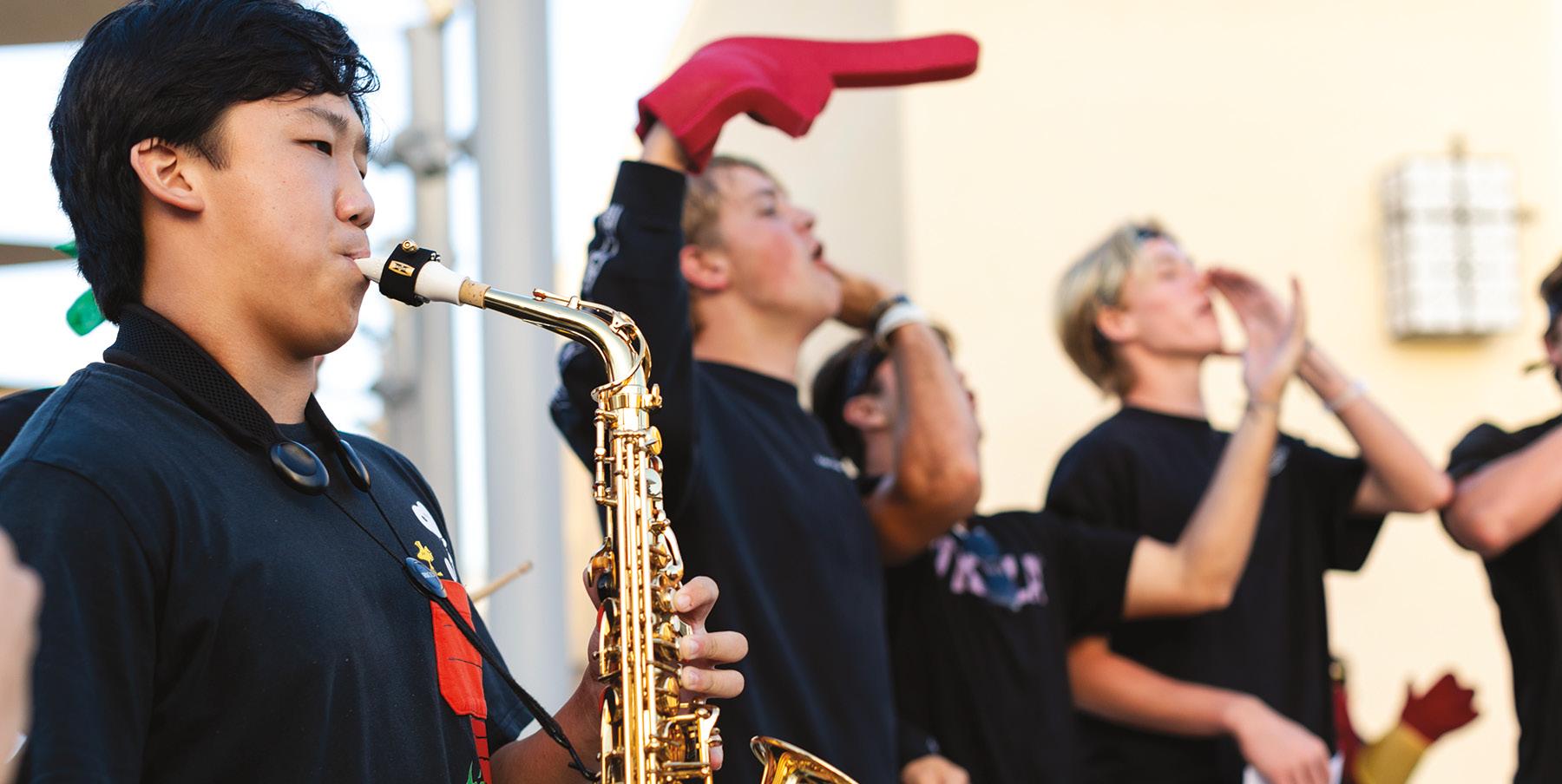
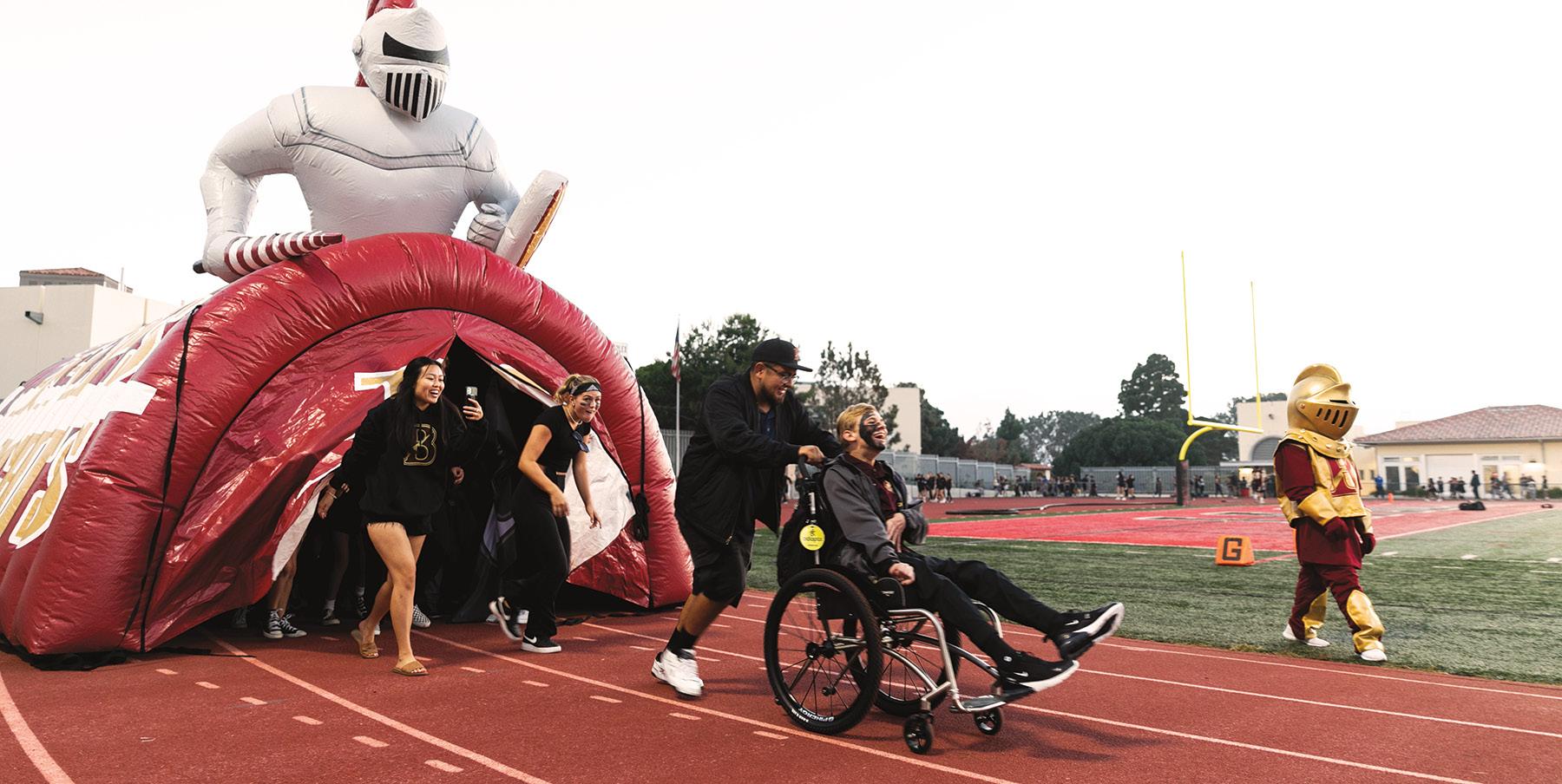
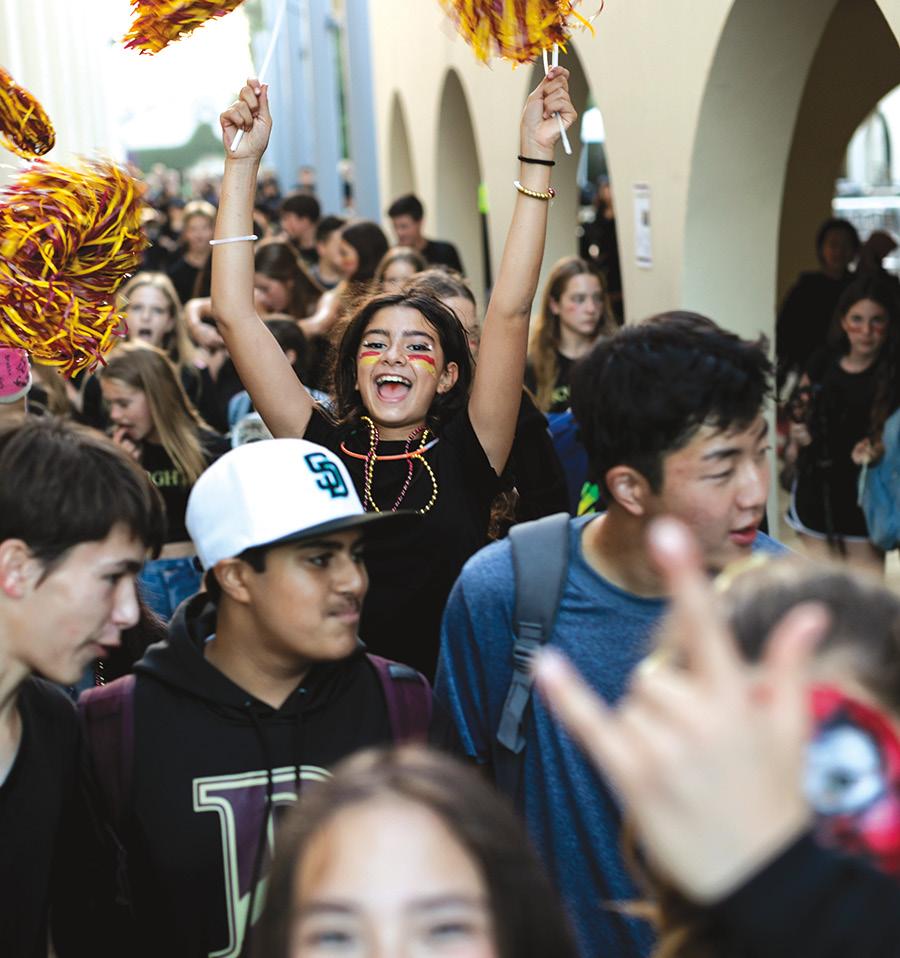

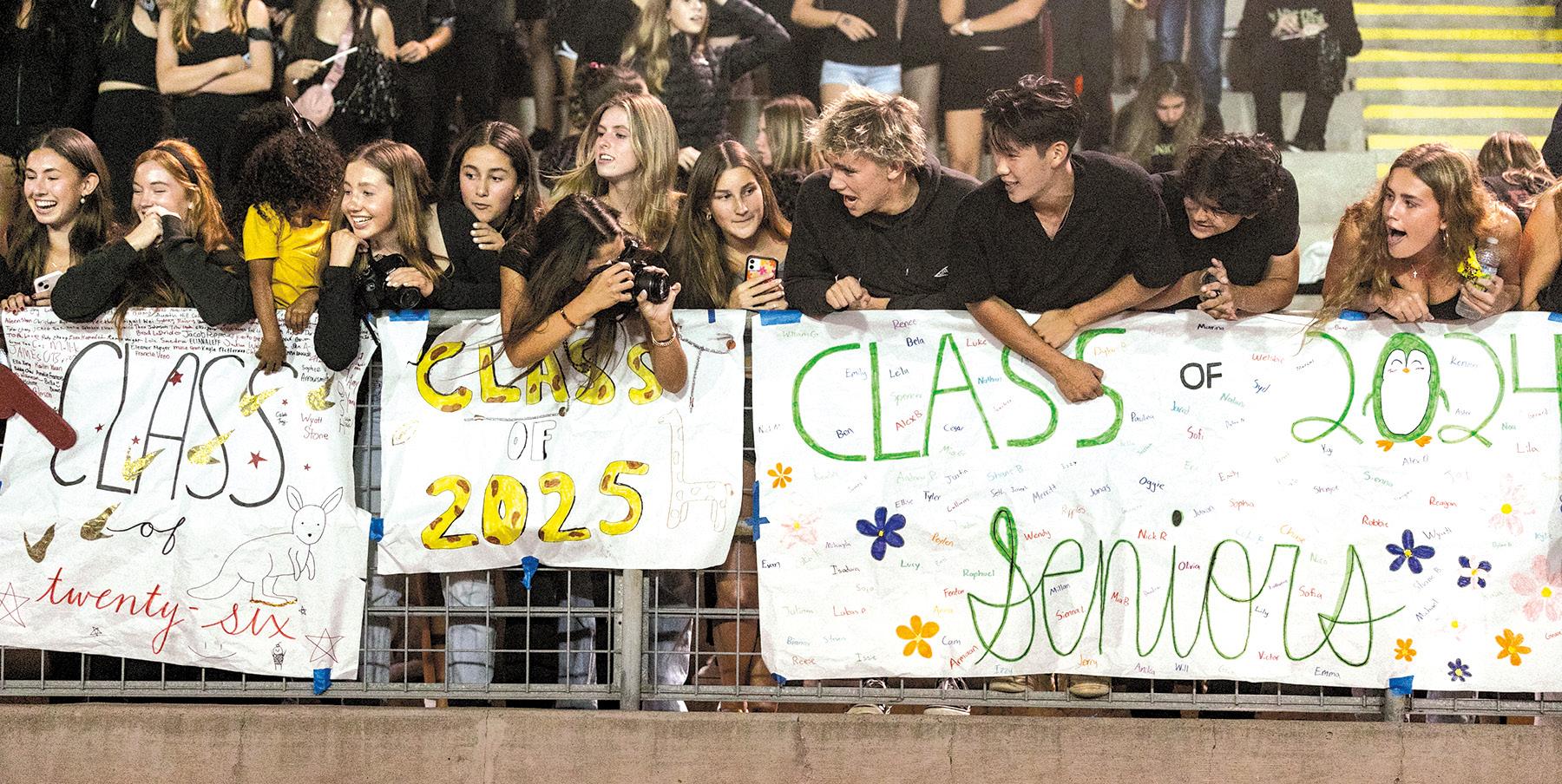
Bowl 16
Bish
HOMECOMING & REUNION WEEKEND 2023
It all started with Bish Bowl on Friday and carried over to Saturday reunions. The festivities included a chapel service; a caffeinated Milk Break; student-led campus tours; lunch; a conversation with Michael Teitelman and Ron Kim (page 18); a carefully curated Bishop’s and San Miguel memorabilia display; a celebration of the Michael and Marlene Teitelman Science Center (page 19); and an all-class evening reception honoring class years ending in threes and eights (pages 26-27).
Following a spectacular sunset, the 50th reunion dinner in honor of the Class of 1973 commenced!
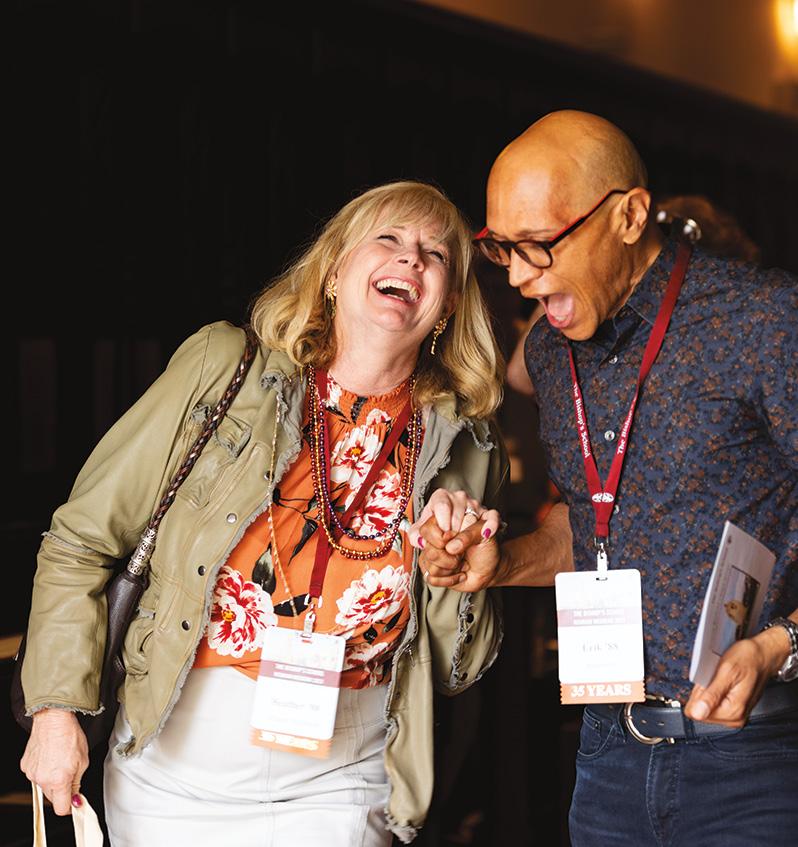
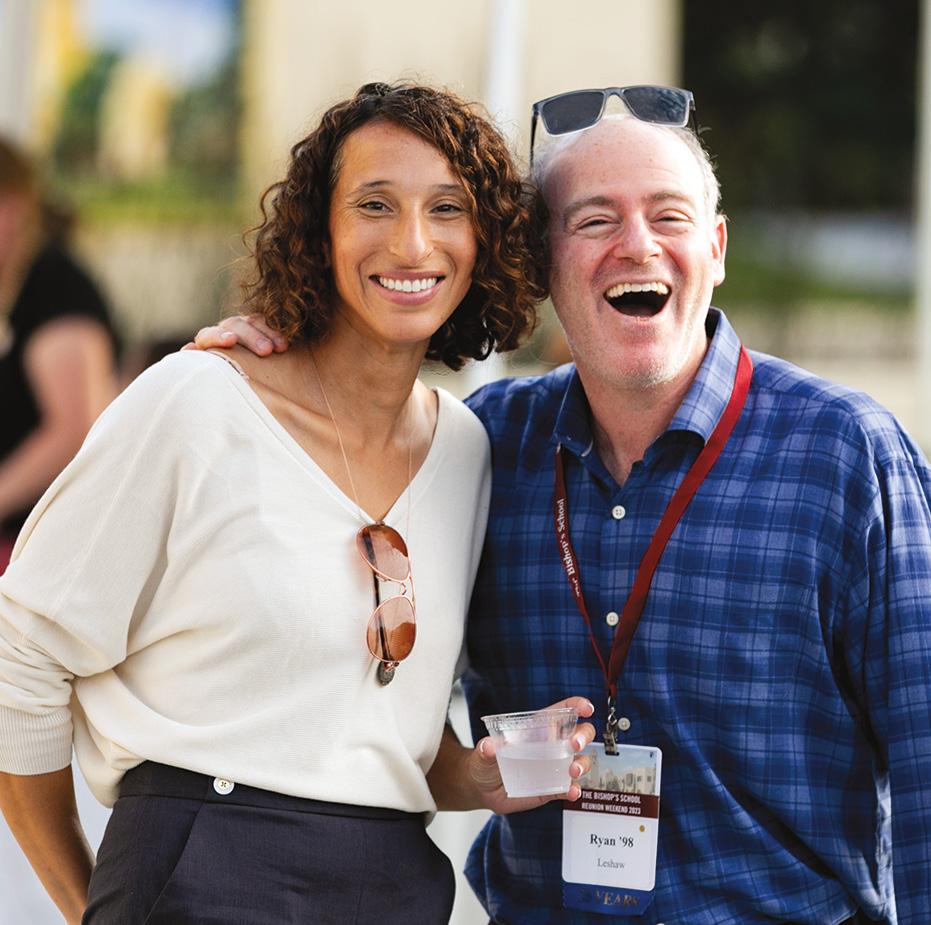
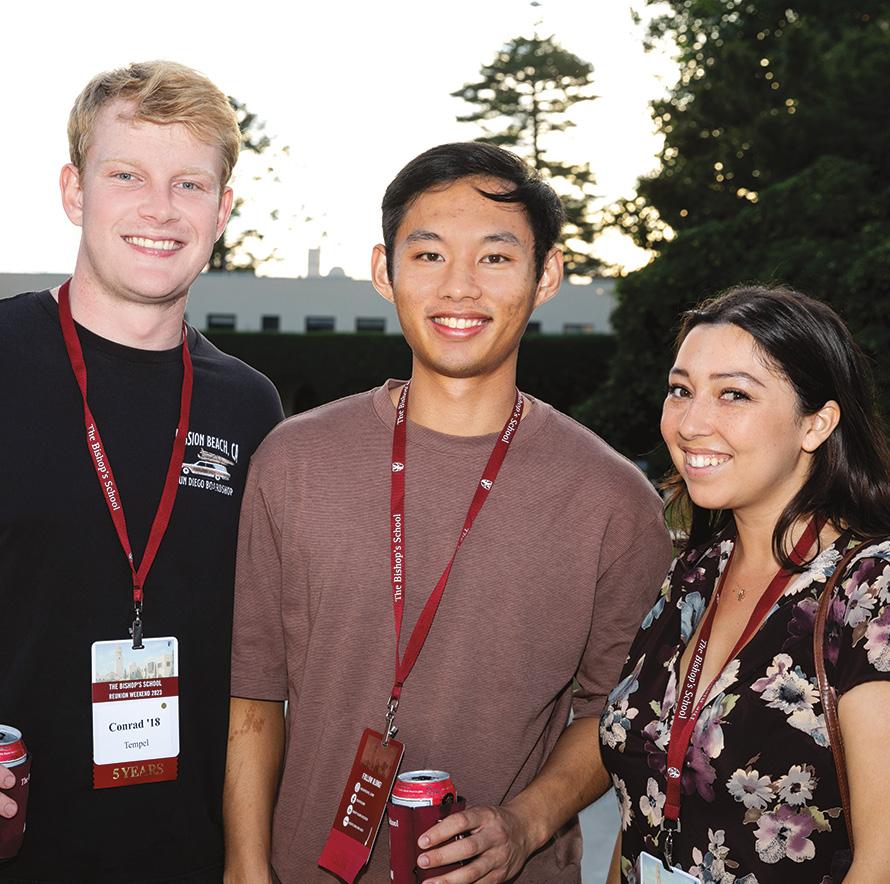
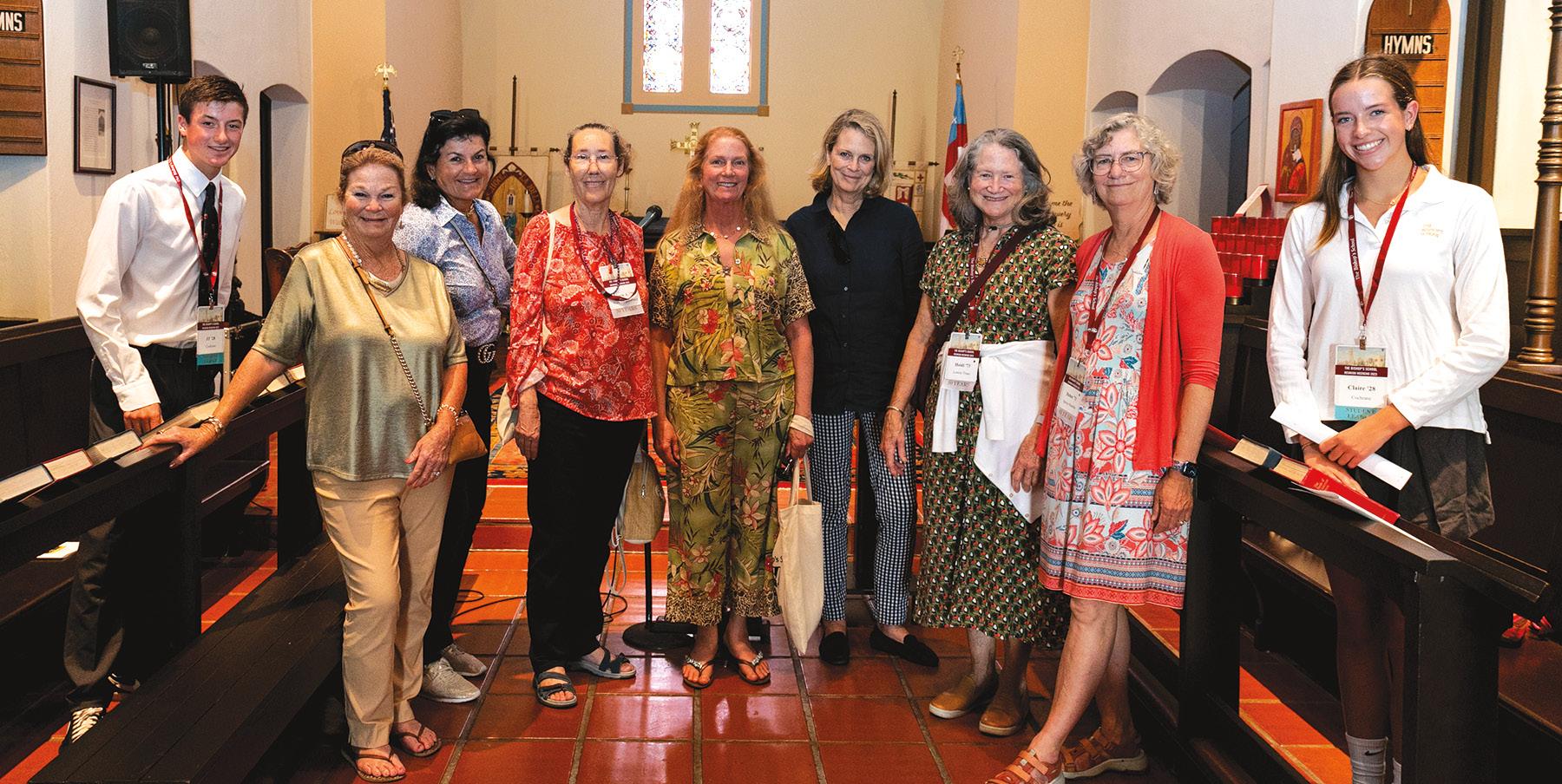
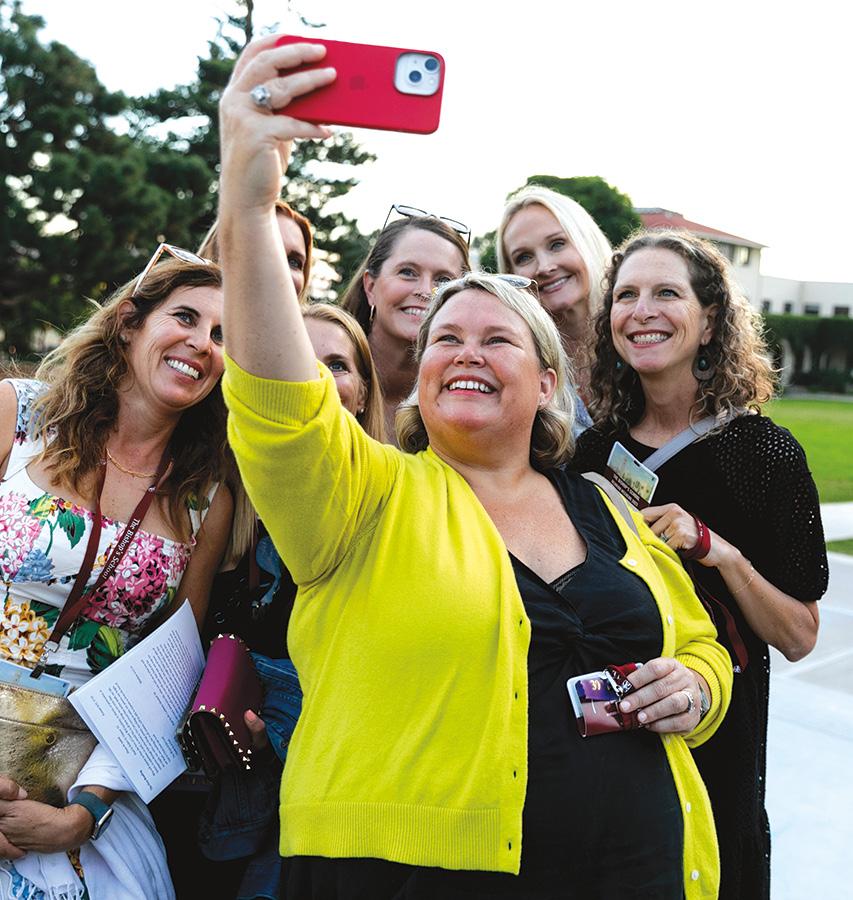
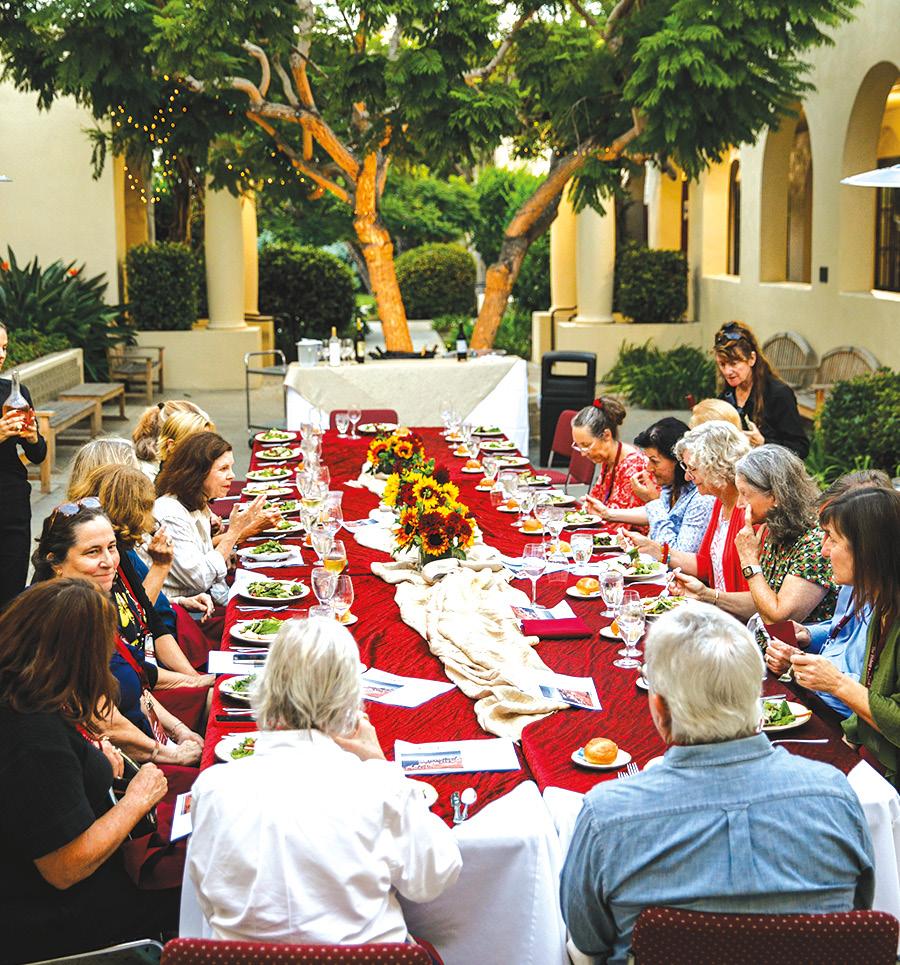
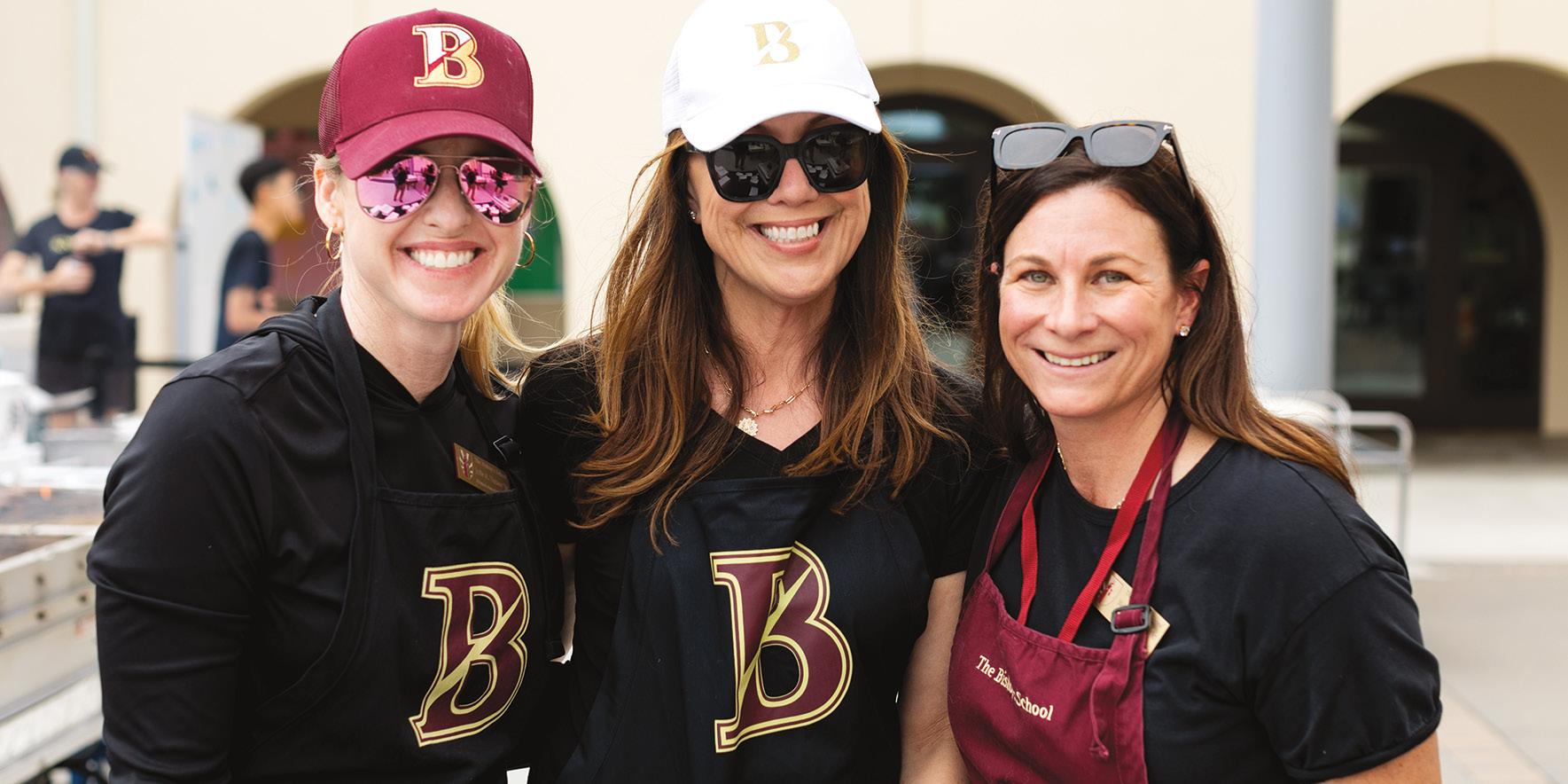
17 Homecoming & Reunion Weekend 2023
Bishop’s Past, Present and Future: A Conversation with Michael Teitelman and Ron
Kim
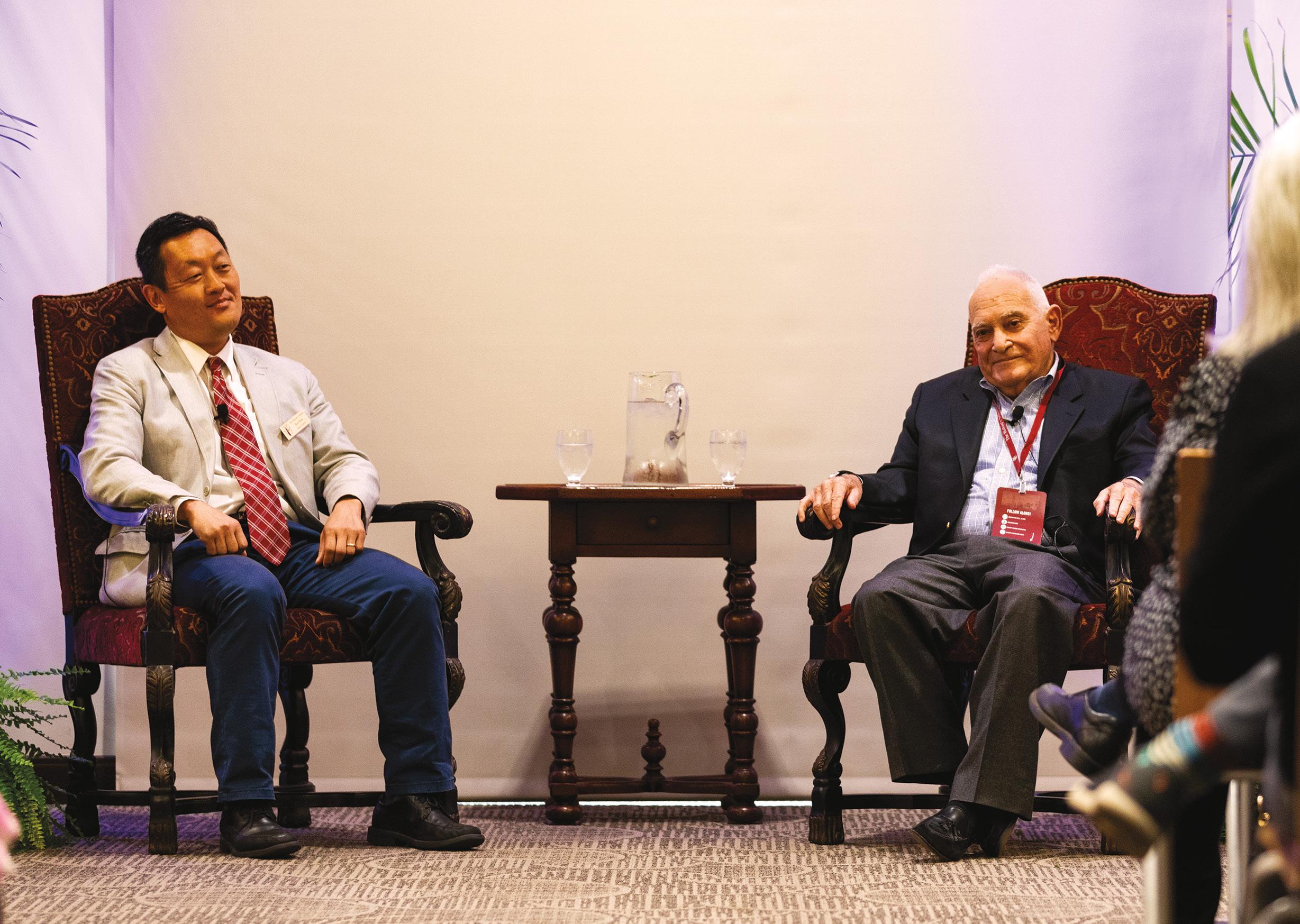 By Cathy Morrison
By Cathy Morrison
The person who best understands the unique nature of your job is someone who has walked the same path. Retired Bishop’s Headmaster Michael Teitelman and current Head of School Ron Kim correspond frequently and occasionally have lunch together. During Homecoming and Reunion Weekend, they let us eavesdrop on their conversation. Moderated by Director of Counseling Megan Broderick ’98, P ’29, the setting was warm and reflective, filled with gentle laughter, nods of agreement and recognition, and appreciative applause.
Describing the campus culture as he began his 26-year tenure, Mr. Teitelman recalls how the board ended Bishop’s boarding component just prior to his arrival in 1983, saying, “What was supposed to be a co-ed day school was really a boarding school culture.” He acknowledges everyone in the room who had a role in developing the day-to-day culture of parent volunteerism and philanthropy required to keep the School on a solid footing while remaining focused on academic excellence. For Teitelman-era alumni and alumni families in the room, the familiar call-and-response, “What is your first priority?” “Academics, academics, academics!” comes readily.
that he spend “a lot of effort trying to build an athletic program that joined that academic program. And at the same time, we built an arts program.”
Coming to Bishop’s from a boarding school, Mr. Kim says he is “delighted that some of that boarding school culture still remains,” sharing, “Students are here early; school happens, school ends, and they’re not—in the stereotypical sense of Hollywood movies—they’re not bursting out of the doors to go home. The kids keep staying here, into the afternoon, the late afternoon, weekends. I see a place where students feel known and cared for and they want to be here.”
“One of the conversations I have with alumni when they come back, is how they’re delighted to see that so much of what remains is familiar to them, and they know that times change, so there’s always this balance. The way I think about it is, they want Bishop’s to get better, but don’t change a thing! That, in some ways, is a conundrum, and in some ways, a guiding thought.”
—Ron Kim
That said, Mr. Teitelman reflects that the transition from an all-girls’ boarding environment to a co-ed day school necessitated
Throughout the conversation, it is apparent how aligned Mr. Kim and Mr. Teitelman are in their educational philosophy, from the importance of really knowing and being visible to the students and the community; to the Episcopal values that connect and guide us; to the critical role of recruiting and retaining a great faculty; to an abiding admiration and appreciation for trustees. Megan comments, “I love the synergy between your answers. You’re both talking about how it’s the people who make this community.”
You can listen in on this conversation!

Bishop’s Past, Present & Future 18

Teitelman Science Center Celebration
By Emily Hassig
A wonderful cross-section of the Bishop’s community—including former trustees, former and current employees, parents, students and alumni came together on Saturday, Oct. 7 during the 2023 Reunion Weekend to celebrate the 15-year anniversary of the center’s dedication to Michael and Marlene Teitelman. The celebration was an opportunity to thank those who were instrumental in bringing the center to fruition, giving them the chance to see all Bishop’s science disciplines in action.
For more than 15 years, the Michael & Marlene Teitelman Science Center has provided laboratory classrooms, research and multi-purpose wet labs and lab-station computers, allowing teachers and students to work closely together, collaborate on experiments and grow their interest in science.
This building also houses the Geier Family Presentation Hall, a 150-seat lecture hall that regularly hosts the Shaffer Family Foundation Endowed Science Lecture Series.
Inspired by these sophisticated facilities, the talent and passion of our science faculty, and the curiosity and creativity of our students, Bishop’s enjoys a well-deserved, stellar reputation in STEM education.
Since this building first opened, it has provided so many opportunities for students to explore the sciences. Bishop’s students have been recognized regionally, nationally and even internationally for their work in a variety of scientific endeavors—from robotics, to DNA research, data sciences, forensics, engineering, machine learning, environmental conservation, food science and more!
Science Department Chair Laura Cummings coordinated the science faculty and student volunteers to demonstrate the depth and breadth of current coursework to alumni and guests during the celebration.
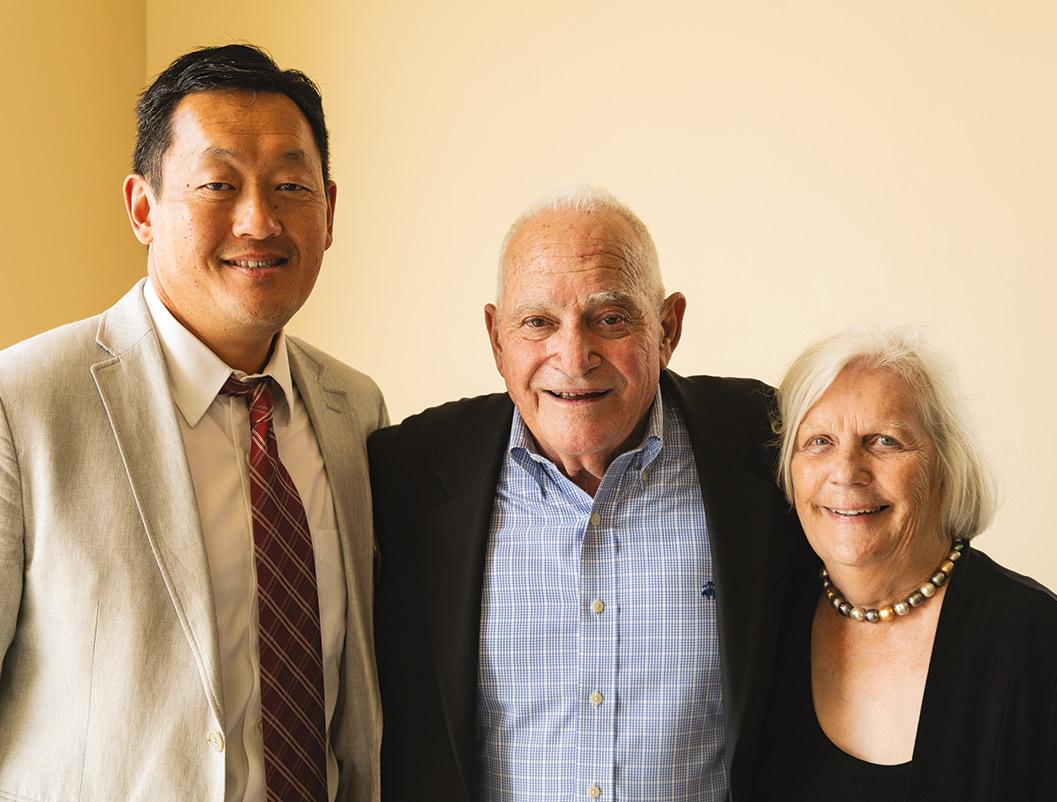
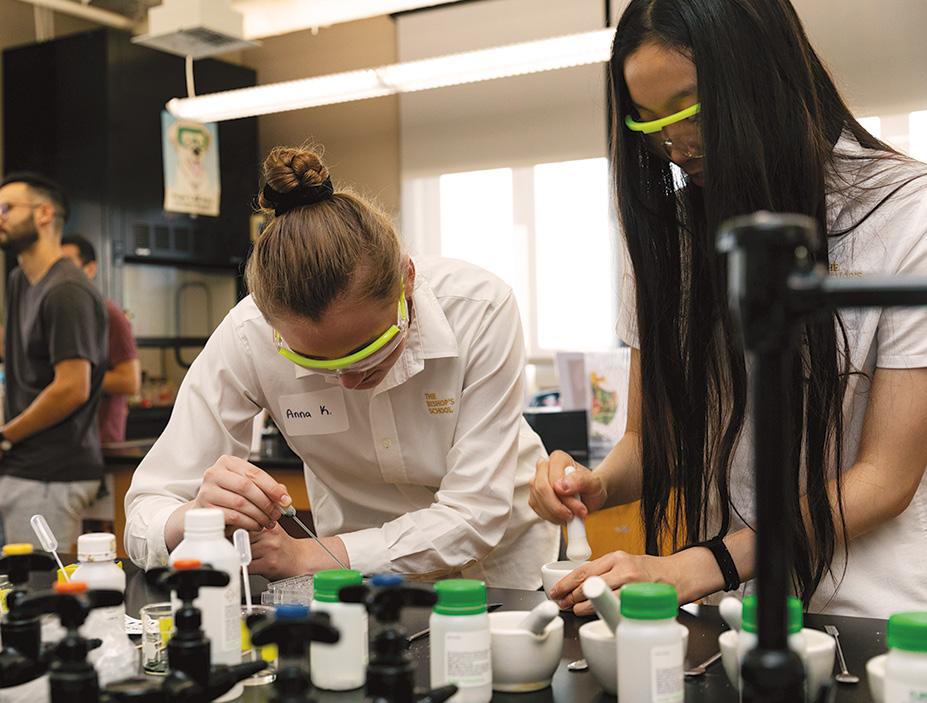

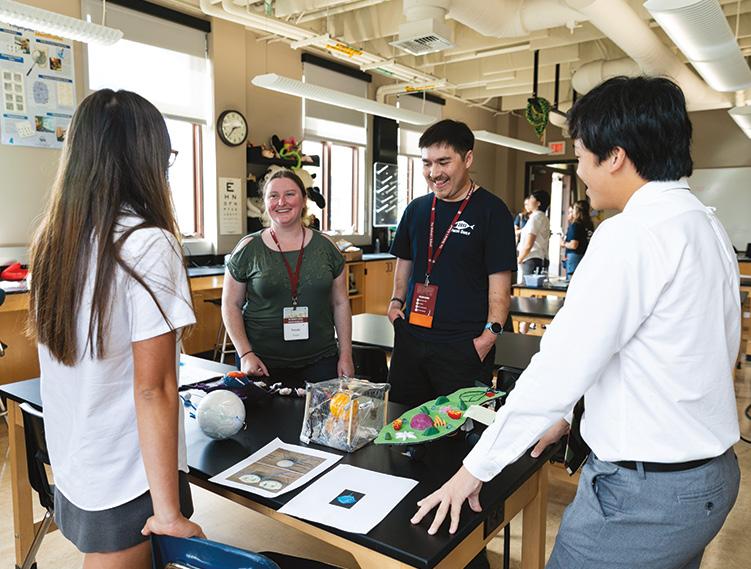
19
Science Center Celebration
Teitelman
Welcoming a New Voice for DEIJ
By Jen Jordan
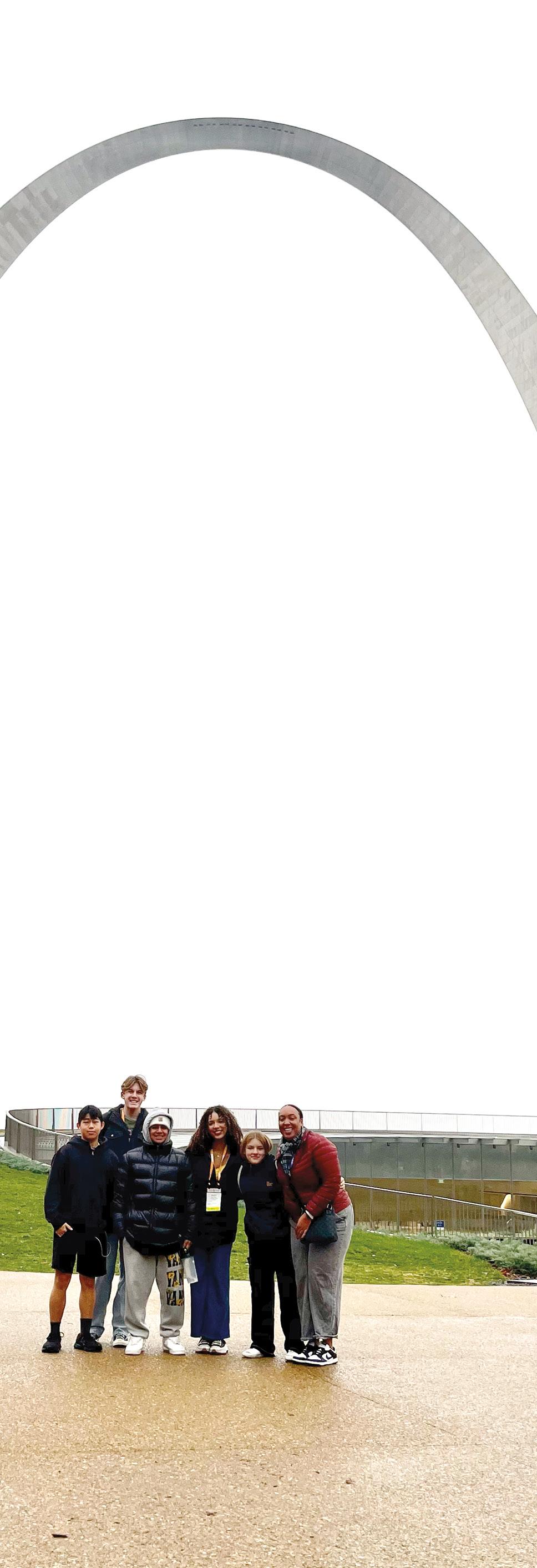
When Bishop’s Director of Diversity, Equity, Inclusion and Justice Valissa Thomas joined our community in August 2023, she immediately felt aligned with the School’s strong commitment to Episcopal values and reputation for fostering a supportive and inclusive environment.
“During my initial interactions with the community, I was impressed by the warmth and enthusiasm of both the staff and students,” she shares. “The collaborative spirit and dedication to creating a dynamic learning environment left a positive first impression, reinforcing my excitement about the opportunity to contribute to such a thriving educational community.”

Valissa appreciates Bishop’s genuine sense of community and commitment to its mission and values. “The collaborative spirit among the faculty, staff and students creates a dynamic learning environment where everyone is encouraged to thrive and do their best,” she says. “The School’s dedication to fostering character development and embracing diversity adds a special dimension to my work, making each day fulfilling and inspiring.”
“I see a future where diversity, equity, inclusion and justice are not just initiatives but ingrained aspects of the School’s identity and experience.”
Valissa previously served as Francis Parker School’s Associate Director of Diversity, Equity, Inclusion and Belonging for Upper and Middle School. “Known for thinking about the student experience in fresh and creative ways,” Bishop’s Associate Head of School Michael Beamer notes, “Valissa’s empathy, warmth and ability to articulate complex information in understandable ways allowed her to become a trusted thought partner by her colleagues.”
Valissa’s experience at Parker and in residential life programs at Semester at Sea, the University of San Francisco and Cal Poly Pomona inspired her deep belief that the power of education, community and belonging can positively transform lives. “With my experience in many educational environments, I felt compelled to contribute to creating more inclusive learning environments for all,” she shares. “Recognizing the importance of diversity and equity in shaping well-rounded individuals, I am motivated to work toward fostering an educational landscape that embraces the richness of all community members’ experiences.”
At Bishop’s, Valissa’s day can include strategic planning, training, programming, engagement and education for the community, collaborating with departments and coordinating events. “The School provides a nurturing environment where being innovative is highly encouraged,” she reveals. “The collaborative culture within the School allows for open communication with colleagues and leadership, creating a supportive network where ideas are shared and challenges are addressed collectively.”
Valissa shares that her vision for the future of DEIJ at Bishop’s is one of continued growth and deep integration into the fabric of the School community. “I see a future where diversity, equity, inclusion and justice are not just initiatives but ingrained aspects of the School’s identity and experience,” she states. This involves ongoing education and awareness programs, structural changes that promote equity, and a commitment to fostering an environment where every individual feels valued and included. “I envision a campus that celebrates diversity in all its forms,” she adds, “where differences are not only acknowledged but embraced, and where students, staff, faculty and the broader community actively engage in conversations about social justice.
“Witnessing the positive impact of the DEIJ program’s efforts on students, staff and faculty and their overall growth fuels my enthusiasm. The shared vision of creating a supportive and enriching educational experience drives and energizes my work at Bishop’s.”
A New Voice for DEIJ; PoC C/ SDLC 20
PoCC/SDLC
This fall, 14 adult and student representatives from The Bishop’s School attended the National Association of Independent Schools (NAIS) People of Color Conference (PoCC) and Student Diversity Leadership Conference (SDLC) in St. Louis.
Through seminars, master classes and workshops, PoCC provides a safe space for leadership, professional development and networking for people of color and allies of all backgrounds in independent schools. SDLC gathers student leaders from independent high schools around the world, focusing on self-reflection, allyship and community building.
“My most significant takeaway from PoCC was the power of collective dialogue and shared experiences,” Bishop’s Director of Diversity, Equity, Inclusion and Justice Valissa Thomas shares. “Engaging with a diverse group of educators and leaders, we gained valuable insights into the challenges faced by educators of color in various independent schools. The conference emphasized the importance of fostering inclusive environments and I left with a renewed commitment to advocating for belonging and inclusion in educational settings.”
Valissa notes that the student attendees uncovered their role in shaping a more inclusive school culture. “Through interactive workshops and discussions, they developed a deeper understanding of the impact student leaders can have in promoting diversity and fostering a sense of belonging,” she says. “The conference inspired them to initiate positive change within their schools, fostering a more inclusive and welcoming community for all students.”
Conferences such as PoCC and SDLC provide a bevy of opportunities for attendees, in addition to building community. “Being in-person provides face-to-face interactions with some of the leading scholars and administrators in the field,” Valissa shares. “In addition to networking, this conference provides interactive sessions and workshops while also being exposed to diverse perspectives from all over the country.
“The conference creates a sense of community and joy for all the attendees, so I hope to develop those same qualities not only for faculty and staff of color, but also for those seeking a variety of ways to belong at Bishop’s,” she says. “Role modeling what an inclusive community can resemble offers our community the opportunity to do the same beyond Bishop’s.”
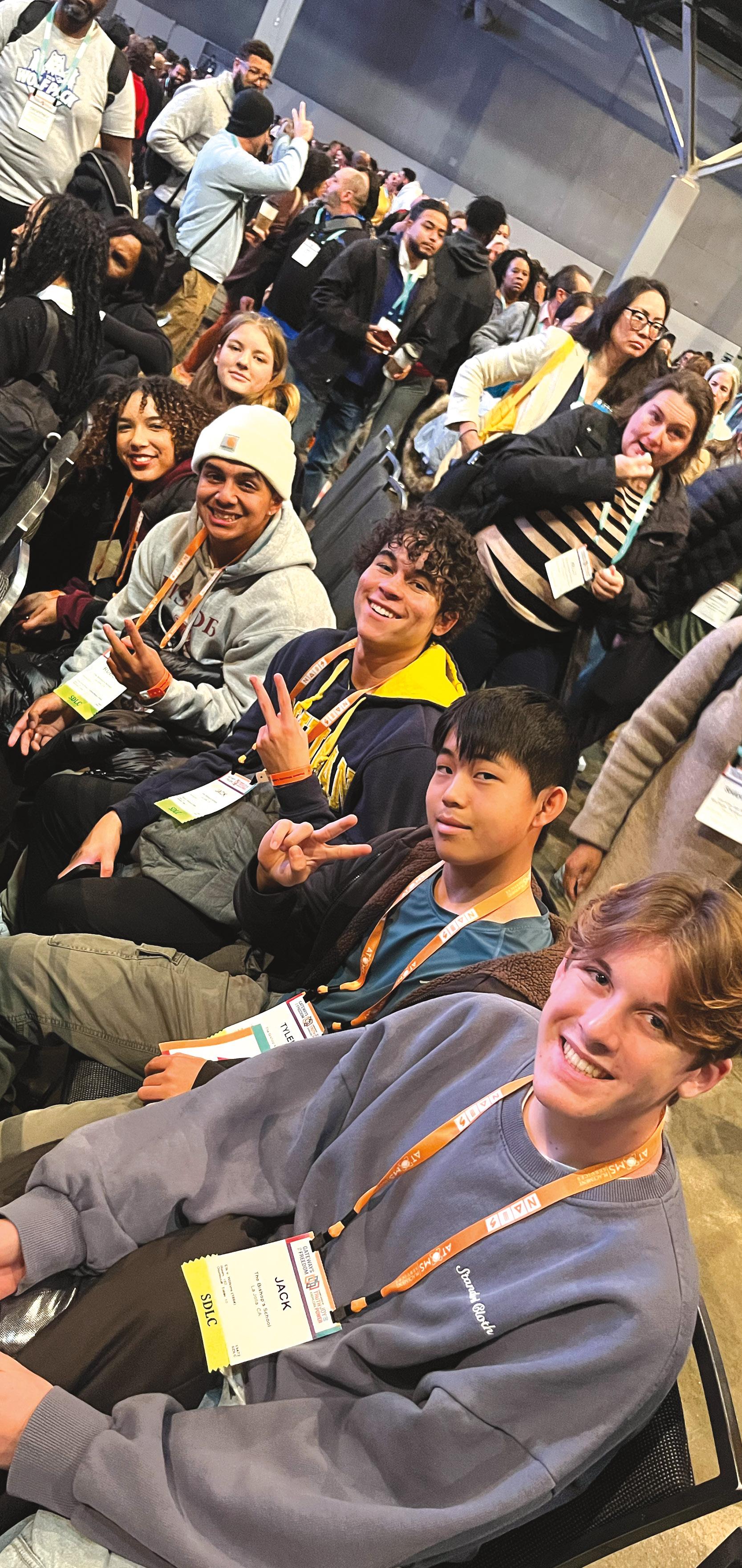
Bishop’s Admissions Director Earns National Recognition
By Cathy Morrison
The Bishop’s School’s Director of Admissions and Financial Aid, Vivien Valenzuela Mallick, recently received the Everett E. Gourley Award from the Enrollment Management Association (EMA). EMA is a professional association for independent school leaders that provides resources, networking opportunities and professional development.
Named for the former headmaster of the Asheville School, the award is given annually to “the educator whose interest in students and concern for colleagues is an inspiration to those who serve in admission,” according to the EMA website.
Recipients are considered “recognized leaders in the field with a passion for admission work, the spirit of vocation and a dedication to service,” writes EMA Vice President of Member Relations Christina Dotchin. The recipient has “modeled inspiration, commitment and integrity, a proven leader in developing and mentoring admission staff and modeling best practices in the recruitment and selection of students.”
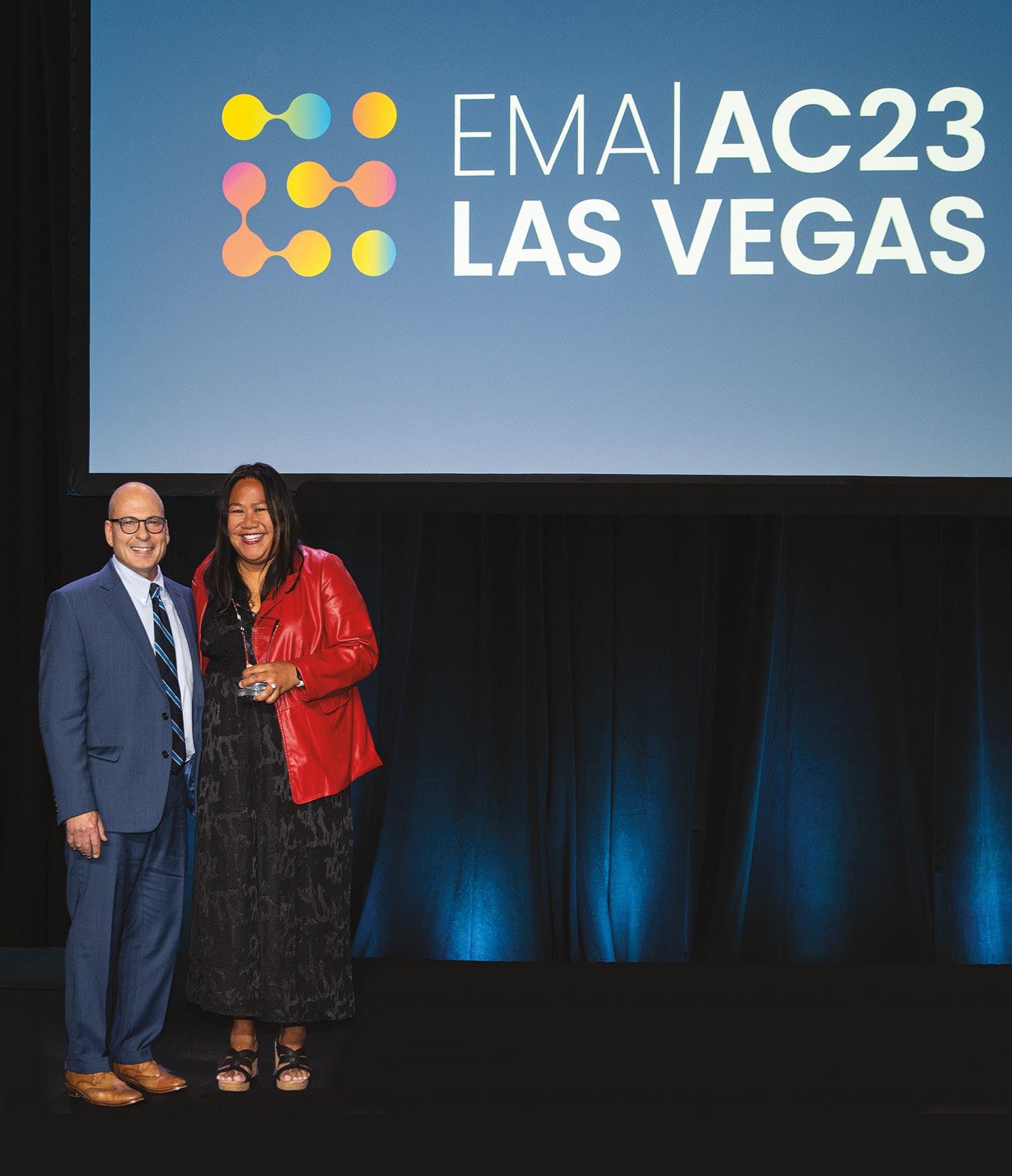
Introducing Vivien at the September 2023 event, her former colleague, Phillips Academy Andover’s Assistant Head of School for Admission and Financial Aid, Jim Ventre, said, “Viv’s intuitive nature, intelligence, warmth and expertise resonate with all who have the good fortune of working with her. What makes Viv so successful as an enrollment manager is her ability to understand the importance of the thoroughness and discernment necessary to successfully match a family with an institution’s culture, as well as identify trends and anticipate the need to cultivate new initiatives.” He continued, “People love Viv because she knows exactly who they are and what is important to them.”
Bishop’s Head of School Ron Kim shares, “The secret to her success is to respect each child, approach the process with utmost integrity and care deeply for her team.”
Vivien joined The Bishop’s School in 2021; since then, she and her team have brought in a record number of completed applications, and the admit rate is the lowest in the School’s history. In addition, she is an assistant coach for the varsity girls’ lacrosse team, which won the 2023 CIF Division I Championship.
She says, “It was an honor to receive the Everett E. Gourley Award and to be recognized by my peers in the independent school industry. It was a privilege to work for Andover for 22 years, and I consider myself truly fortunate to be part of an amazing admissions and financial aid team here at Bishop’s. Bishop’s core values—integrity, compassion, inclusion and justice—mirror my own values as a professional and as a parent.”
Well-Deserved National Recognition 22

Goals and Aspirations for T he Bishop’s School
By Mac Armstrong ’93, P ’25, ’27, ’29
As a second-generation board president—my father also served in this role when I was a Bishop’s student—I’m thrilled to follow in his footsteps, and to see how the School has evolved over time and cemented itself as one of the best academic institutions on the West Coast and nationwide. As an alum and a current parent, I care deeply about Bishop’s and its future. Embarking on a comprehensive campaign, I am excited to lead the board and the campaign steering committee to ensure that the School we love remains a leader in independent school education.
On behalf of Head of School Ron Kim and his advancement team, thank you to all the members of the Bishop’s community who shared insight and inspiration through our feasibility study and community survey. Your thoughtful responses were compiled confidentially and shared with Bishop’s board of trustees in a special session convened on Jan. 18, 2024. In that meeting, we identified major themes and priorities for a comprehensive campaign.
The following priorities have emerged (in no particular order):
• Recruit, retain and compensate the faculty who nurture our students and support their well-being and excellence.
• Build the financial aid endowment to ensure the Bishop’s experience is as affordable and accessible as possible.
• Construct a performing arts center to better serve the students’ creative ambitions.
• Establish a high-performance athletics center that enables athletes to achieve their potential and supports the well-being of all of our students.
• Continue the growth of The Bishop’s Fund (see facing page).
The inclusion of capital projects and annual/endowed programs is why we are calling this a comprehensive campaign. The Bishop’s Fund (unrestricted annual giving) and endowment growth are key to our overall success.
Joining me in leading this endeavor are the steering committee co-chairs pictured here: Doug Arthur ’99, P ’30; Kyndra Leach P ’24, ’27, ’30; and Juli Oh Browne P ’20, ’23, ’25. We look forward to working with Ron Kim and Chief Advancement Officer Emily Hassig to further define the scope and capacity of this comprehensive campaign in the coming months. We anticipate having more news and opportunities to share with you soon!
If you have questions about the campaign, or would like more information, please contact Emily at emily.hassig@bishops.com.
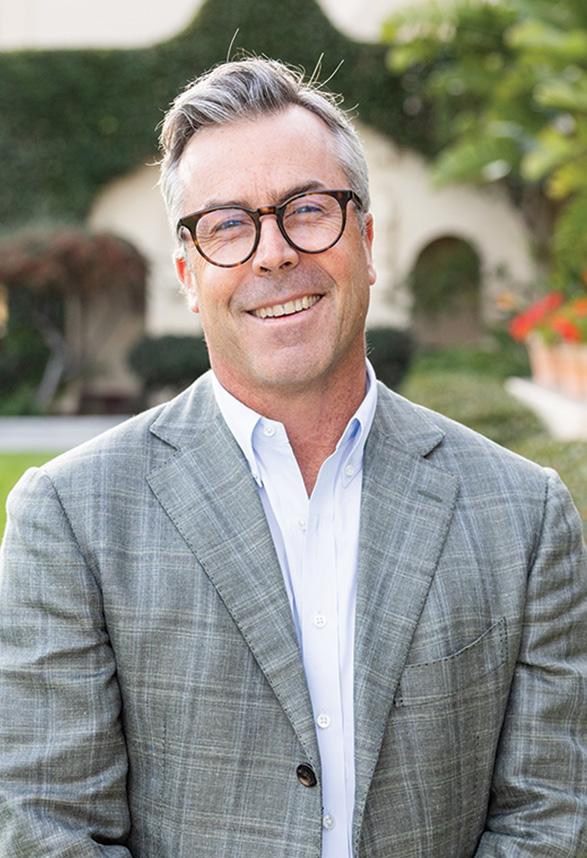

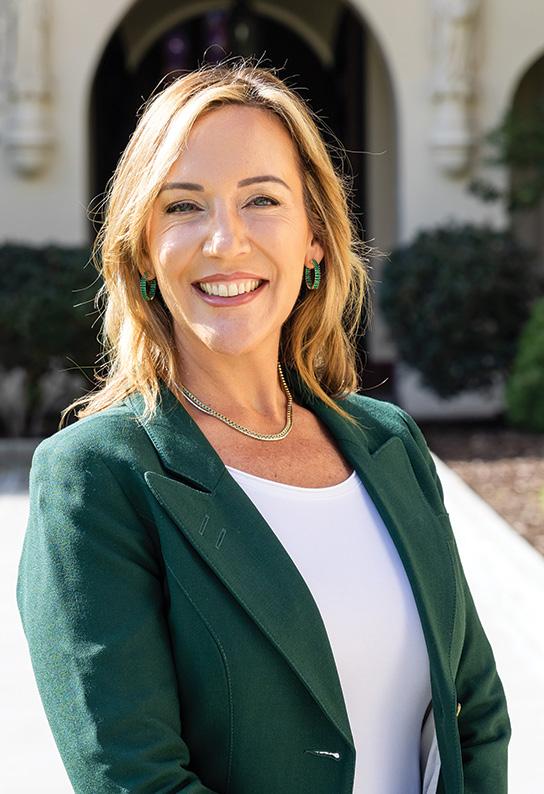
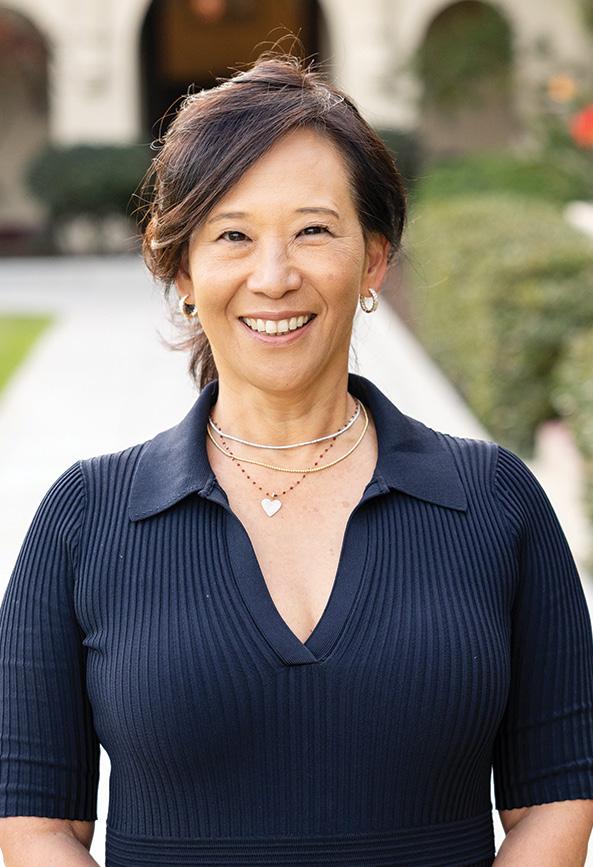 Mac Armstrong ’93, P ’25, ’27, ’29
Doug Arthur ’99, P ’30
Kyndra Leach P ’24, ’27, ’30
Juli Oh Browne P ’20, ’23, ’25
Mac Armstrong ’93, P ’25, ’27, ’29
Doug Arthur ’99, P ’30
Kyndra Leach P ’24, ’27, ’30
Juli Oh Browne P ’20, ’23, ’25
The Bishop’s School
7607 La Jolla Boulevard
La Jolla, California 92037-4799
GREATER PURPOSE
As an Episcopal school, we embrace Ellen Browning Scripps’ invitation to “make life a little better to live” and the Episcopal commitments “to love our neighbors as ourselves” and “to strive for justice and peace among all people, and respect the dignity of every human being.”
In order to act with greater purpose, students need to:
(1) know who they are, what matters most to them, and where they find meaning and joy in their lives (Discernment);
(2) identify the difference between a goal and a purpose, and learn how to construct their lives around worthy commitments (Discernment);
(3) develop a “beyond-the-self motivation” and a sense of responsibility and concern for the world around them (Discovery);
(4) believe that change is possible (Hope), and trust that they have something of value to contribute (Agency).
Hope + Agency ››› (Action)


Non-Profit Organization U.S. Postage PAID The Bishop’s School
Families of alumni, if your child no longer maintains an address at your home, please provide an updated address to the alumni office. (858) 875-0505 • Fax (858) 456-2681 • tbsalumni@bishops.com Scan the QR code to learn more about greater purpose at Bishop’s.



















































 By Cathy Morrison
By Cathy Morrison













 Mac Armstrong ’93, P ’25, ’27, ’29
Doug Arthur ’99, P ’30
Kyndra Leach P ’24, ’27, ’30
Juli Oh Browne P ’20, ’23, ’25
Mac Armstrong ’93, P ’25, ’27, ’29
Doug Arthur ’99, P ’30
Kyndra Leach P ’24, ’27, ’30
Juli Oh Browne P ’20, ’23, ’25
